Organic Hawaii
Natural Health - Island Style!
How to Make All-Natural Bug Spray for your Garden Step-By-Step DIY
Learn how to make your own DIY (do-it-yourself) all natural and organic garden bug spray at home to naturally kill and repel those annoying garden bugs such as whiteflies, mealybugs, aphids, and other garden pests.
This easy step-by-step guide will show you exactly how you can do it using commonly available kitchen ingredients and essential oils. By the way, here’s a video where I show you this too.
Affiliate disclaimer: As an Amazon Associate I earn from qualifying purchases. You don’t get charged extra. Mahalo for your support! Safety disclaimer: please keep all garden bug spray ingredients and tools out of reach of children. Not for human consumption. Garden use only. Header image by: Matt Davenport.
“Like most gardeners, I used to buy natural garden bug spray from the garden store. But then I thought to myself: “Why not make my own bug spray that’s better and cheaper?!” So I did! And now I’d like to share my special DIY recipe with you in 3 EASY STEPS!”
Natural Garden Bug Spray Ingredients and Tools
You will need the following ingredients:
- 3 cups of purified/filtered water (regular water from the tap is OK, but I recommend filtered especially for edible plants). Advanced Gardening Tip: (optional) use colloidal silver water instead of regular water to reduce soil/plant pathogens like bad bacteria, fungi, and viruses.
- Organic vegetable oil You probably already have this in your kitchen. You can use any non-gmo oil made from vegetables, seeds or grains. Soy, sunflower, grapeseed, safflower, corn, coconut, avocado, etc.
- Dr. Bronner’s Peppermint soap This can be any natural soap in liquid form. I like Dr. Bronner’s because it has peppermint in it already (bugs don’t like it) and it’s a great company with a great message and trusted ingredients. I regularly use it as body wash, so it’s multipurpose.
- Peppermint essential oil – if your soap doesn’t have it, this is a good essential oil to add and have on hand. Helps with headaches and just a great refreshing essential oil to diffuse in the house, when not spraying bugs 🙂
- Tea tree (Melaleuca) essential oil – another must have essential oil. I also use this one on mosquito bites to relieve the itch fast with other beneficial antimicrobial uses – even in toothpastes.
You will need the following tools:
- Spray bottle (for minor applications) or Pressure sprayer (for large areas of the garden)
- Measuring container (optional) – to measure your ingredients, otherwise you have to eye it out.
- Measuring spoon (optional) – to measure your ingredients, otherwise you have to eye it out.
- Smart scale (optional) to measure your ingredients, otherwise you have to eye it out.
- Water filter (optional) to filter out chlorine, heavy metals, and other contaminants
Step 1: Create the Solution
Mix 1 cup of vegetable oil with 1 tablespoon of natural soap. Add liberal amounts of essential oils (peppermint and tea tree): 20-30 drops. Stir.
Step 2: Dilute the Solution
Add 1.5 teaspoons of Solution to every cup of water. Or 1 tablespoon for every 3 cups of water. Or about 5-6 tablespoons of Solution per 1 gallon of water. Then stir or shake.
Step 3: You’re done!
Fill up your sprayer with your freshly created garden bug spray and SPRAY! Spray your plants from above and BELOW.
Make sure the Sun is not out when spraying, so early morning or evening are best. If you think your plants might be sensitive, do a test run: spray only part of the plant to see how your plant reacts before spraying everything just to be safe.
Reapply every 7 days, as needed, until the bugs go away!
I hope this natural DIY garden bug spray works out for you! It certainly did for me and that’s why I wanted to share my homemade recipe with you. Let me know how it goes in the comments below! Mahalo!
22 Health Benefits of Noni: Scientific Studies and Research
Without a doubt, Noni is a superfood superfruit, with lots of important health benefits backed by modern science and a rich history of traditional use.
To summarize, the results of these studies show that Noni may have the following health benefits:
- Enhances the immune system.
- Enhances endurance, athletic performance, and decreases fatigue.
- Anti-microbial, antibacterial, antiviral, anti-fungal (including candida).
- Lowers blood pressure. Anti-diabetic. Helps metabolism / obesity.
- Anti-depressive and anti-psychotic. Increases sense of well-being, calming, relaxing, and stabilizes mood.
- Pain relief (analgesic), including arthritis.
- Helps against parasitic worms (anthelmintic / antihelminthic).
- Treats gastric problems and enhances digestion.
- Heart health, lowers bad cholesterol.
- Reduces atherosclerosis (hardening of the veins).
- Reduces growth of cancer cells / possesses anti-tumor properties.
- Antioxidant, free-radical scavenger properties.
- Liver-protecting properties.
- Anti-inflammatory properties.
- DNA protective properties.
- Helps with brain health including memory.
- Relieves symptoms of gout.
- Reduces muscle spasms.
- Skin health, anti-wrinkle, pro-collagen.
- Speeds up healing of wounds.
- Source of at least 19 important phytochemicals (2 of which were previously unknown) important to health, with perhaps more scientific discoveries, as modern science is able to recognize them.
- According to studies correlated with TCM (Traditional Chinese Medicine) Noni is tonifying kindey and liver, strengthening tendon and bone, yiqi yangyin. The clinical application of Noni is used for liver and kidney deficiency, waist and knee weakness, weak muscles and bones; Qi and Yin deficiency, tiredness and thirst.
As a friendly reminder, please consult your qualified health practitioner if you have any medical condition, nursing, or pregnant. The information in this article is not a prescription or medical advice.
Scientific Studies and Research on Health Benefits of Noni
The following is a list of 3rd party published scientific research and studies on the numerous health benefits of Noni (Morinda citrifolia). Noni is a traditional medicinal canoe plant brought over to Hawaii by the ancient ocean-fairing Polynesians.
More recent studies on Noni are also available on PubMed. Additionally, University of Hawaii has an excellent page dedicated to the research of Noni health benefits.
If you’d like to learn how to make your own Noni juice at home check out our step-by-step guide.
Tip: to quickly find a specific keyword use Ctrl+F on PC or Command+F on Mac.
(In reverse chronological order)
J Ethnopharmacol. 2008 Feb 12;115(3):502-6. The effects of Morinda citrifolia L. (noni) on the immune system: Its molecular mechanisms of action. Palu AK, Kim AH, West BJ, Deng S, Jensen J, White L.
The aim of this study was to investigate the mechanisms involved in the immunomodulatory effects of Morinda citrifolia L. (noni) in vitro and in vivo in mice. In vitro, Tahitian Noni Juice (TNJ) and Noni fruit juice concentrates (NFJC) (1, 5mg/mL) potently activate cannabinoid 2 (CB2), but inhibit cannabinoid 1 (CB1) receptors in a concentration-dependant manner. In vivo, oral administration of TNJ ad libitum for 16 days decreased the production of IL-4, but increased the production of IFN-gamma. These results suggest that noni modulates the immune system via activating of the CB2 receptors, and suppressing of the IL-4, but increasing the production of IFN-gamma cytokines. It may also exert beneficial immunomodulation effects in conditions involving inadequate immune responses.
Poster # 208. Joint Northwest and Rocky Mountain Regional Meeting of the American Chemical Society. June 17, 2008. Park City, Utah, USA. Noni juice increases athlete endurance via antioxidant mechanism. Brett J. West, C. Jarakae Jensen.
Noni (Morinda citrifolia) fruit juice was traditionally used in Polynesia to promote endurance on long ocean voyages. Further, in vivo tests have revealed that noni juice can significantly increase endurance. Two human clinical trials in non-athletes have revealed that noni juice can improve physical functioning and fatigue indices of quality of life surveys. Chemical analysis, as well as human clinical research, has revealed that no chemical stimulants, illicit drugs, or otherwise prohibited substances occur naturally in noni fruit juice. It was, therefore, proposed that the notable antioxidant activity of noni juice is the mechanism responsible for the anti-fatigue (or pro-ergogenic) effect. To test this hypothesis, commercial noni juice from French Polynesia was evaluated in 40 highly trained athletes (ages 18-27 yr). The athletes were divided into two groups of twenty each, with one group consuming noni juice and the other consuming blackberry juice as controls. Each subject consumed 100 mL BID of either noni juice or blackberry juice for three weeks. For each athlete, the time-to-exhaustion in the treadmill test (increasing resistance), blood analyses, and urine chemiluminescence analyses were performed at day 0, day 10, and day 21 of the test. By day 21, the time-to-fatigue of the noni juice group was increase by 22% (p<0.05), whereas no increase was observed in the blackberry juice group. Blood analyses did not reveal any significant effects, with the exception of increased mean lactate level in the blackberry juice at day 21. Chemiluminescence decreased by 25% in the noni juice group (p<0.05), demonstrating a significant decline in lipid peroxidation, due to the antioxidant activity of noni juice. This confirms the hypothesis that improvement in physical performance and energy is associated with noni juice’s antioxidant properties. Further, the ability of noni juice to improve endurance in highly trained young athletes is demonstrated.
J Sci Food Agri. 2007 November; 87(14): 2583-2588. Safety tests and antinutrient analyses of noni (Morinda citrifolia L.) leaf. West BJ, Tani H, Palu AK, Tolson CB, Jensen CJ.
Noni (Morinda citrifolia L.) leaves have a documented history of food use. However, previous safety and antinutrient studies are absent. The current investigation was conducted to assess the utility of noni leaves as food. RESULTS: No evidence of toxicity or differences in weight gain were observed in acute, subacute, and subchronic oral toxicity tests of ethanol–water (1:1 v/v) and hot-water extracts of noni leaves in mice at doses of 2000, 200, and 20 mg kg−1 body weight, respectively. Acute systemic anaphylaxis tests of the ethanol–water (4:1 v/v) and hot-water extracts were negative. Further, leaf proteins were readily digested in simulated gastric fluid. Tannic acid concentrations in frozen and dried leaf were 1.6 and 25.8 g kg−1, respectively. Phytic acid was not detected in the raw leaf (
Phytotherapy Research. 2007 Nov; 21(11):1100-1101. Evaluation of the ergogenic potential of noni juice. Ma DL, West BJ, Su CX, Gao JH, Liu TZ, Liu YW.
Morinda citrifolia (noni) fruit juice is an increasingly popular health food with many reported benefits, such as antioxidant and immunomodulatory properties. Traditionally, noni fruit was used by Polynesian to combat fatigue. Also, clinical studies have revealed that noni juice consumption improves quality of life scores relating to physical functioning and energy levels. To further evaluate the ergogenic (anti-fatigue and endurance promoting) potential of noni juice, aged mice were pretreated orally with increasing doses (10, 20, and 40 mL/kg body weight) of Tahitian Noni® Juice (TNJ) and then compared to young and aged controls in the forced swim test and rotarod test. The average times of all TNJ dose groups were significantly longer than the aged controls in both the swim test (36 to 45 %) and the rotarod test (59 to 128 %), and were similar to those of the youth controls. This demonstrates not only an improvement in endurance but also in balance and flexibility. These results confirm the reported use of noni juice to combat fatigue, improve endurance, and increase overall physical performance.
Phytomedicine 2007; 14:517–522. Noni as an anxiolytic and sedative: A mechanism involving its gamma-aminobutyric acidergic effects. Deng S, West BJ, Palu AK, Zhou BN, Jensen CJ.
Noni (Morinda citrifolia) is increasing in worldwide popularity as a food or dietary supplement with versatile health benefits. The aim of this study was to investigate the effects of Noni fruit on anxiety symptoms in vitro. To this end, a competitive GABAa receptor-binding assay was developed. Our preliminary study indicates that the methanol crude extract of Noni fruit showed significant affinity to the gamma-aminobutyric acid A (GABAa) inhibitory neurotransmitter receptors, and displayed 75% binding inhibition of the agonist radioligand [3H] muscimol at a concentration of 100 mg/ml. Further experiments demonstrated that the MeOH extract, and its BuOH and H2O partitions, exhibited IC50 values of 22.8, 27.2, and 17.1 mg/ml, respectively, in the GABAa-binding assay. Experimental results with Noni fruit indicate the presence of competitive ligand(s), which may bind to the GABAa receptor as an agonist, and thus induce its anxiolytic and sedative effects. The study provides an in vitro rationale for one of Noni’s versatile and traditional uses. In addition, an HPLC fingerprint profile of the methanolic extract of Noni fruit has been established for quality control purpose.
J Nat Prod. 2007 May;70 (5): 859-862. Lipoxygenase Inhibitory Constituents of the Fruits of Noni (Morinda citrifolia) Collected in Tahiti. Deng S, Palu AK, West BJ, Su CX, Zhou BN, Jensen JC.
A phytochemical study of the fruits of noni (Morinda citrifolia) collected in Tahiti led to the isolation of two new lignans, (+)-3,4,3’,4’-tetrahydroxy-9,7’α-epoxylignano-7α,9’-lactone (1) and (+)-3,3’-bisdemethyltanegool (2), as well as seven known compounds, (-)-pinoresinol (3), (-)-3,3’-bisdemethylpinoresinol (4), quercetin (5), kaempferol (6), scopoletin (7), isoscopoletin (8), and vanillin. The structures of 1 and 2 were determined by spectroscopic techniques. Compounds 3, 6, and 8 were isolated for the first time from noni fruit. Compounds 1-8 were shown to inhibit 5- and/or 15-lipoxygenase, with IC50 values ranging from 0.43 to 16.5 μM. Compound 5 exhibited weak inhibitory activity toward cyclooxygenase-2.
NONI RESEARCH: 2006
International Journal of Food Sciences and Nutrition, 57(7):556-558, 2006. Mineral variability among 177 commercial noni juices. Brett J West, Charles B Tolson, Randy G Vest, Summer Jensen, Travis G Lundell.
The industry-wide mineral profile of commercial noni juices was determined by analyses of 177 competing brands by Tahitian Noni International laboratories. A large degree of variability was found in the concentrations of nine minerals, revealing that not all noni juices are the same. Many brands of noni juice have a different nutrient profile than that published by the European Union for TAHITIAN NONI® Juice. While potassium was found to be the most prominent mineral, its concentration in most commercial brands is of minor nutritional significance, contrary to claims made in some previous publications that were based only on the analysis of one minor brand name. (view original abstract).
Journal of Food Science, Vol. 71(8):R100-106, 2006. A safety review of noni fruit juice. B. J. West, C. J. Jensen, J. Westendorf, L. D. White
A literature review and data from news studies are presented to describe the safety of noni fruit juice. Several preclinical safety tests and human clinical studies have revealed no adverse health effects, even at very high doses. The data from these studies support the continued use of noni juice as a safe healthy food. (original article)
World Journal of Gastroenterology, Vol. 12(22) pp. 3616-3619. June 2006 Noni juice is not hepatotoxic. B. J. West, C. J. Jensen, J. Westendorf
Noni juice has been approved as a safe food within the European Union. A few cases reports suggesting a role of noni juicein acute hepatitis, due to anthraquinones, is not supported by chemical analyses, several preclinical safety studies, and a clinical human safety study in 96 volunteers. Liver function tests in these studies revealed no adverse liver effects, even at very high doses. Anthraquinones in noni fruit are of the wrong type and occur in quantities too small to cause any negative liver effects. A large amount of data reveal that noni juice is not hepatotoxic. (original article)
The 232nd American Chemical Society National Meeting, San Francisco, CA. September 10-14, 2006. Evaluation of the allergenic potential of Morinda citrifolia L. leaf proteins, AGFD 158. Brett J West and Afa Palu.
Analysis of proteins from noni leaves reveals that they are easily digested by pepsin, a digestive enzyme in the stomach that breaks down proteins. A characteristic of non-allergen food proteins is that they are readily digested by pepsin. This provides further evidence for the safe use of noni leaves as food. (view original abstract)
The 232nd American Chemical Society National Meeting, San Francisco, CA. September 10-14, 2006. Noni contains competitive ligand(s) binding to GABAa agonist receptors as an anxiolytic. Shixin Deng, Afa K Palu, Bing-Nan Zhou, Jarakae C. Jensen, Brett J West. AGFD 67.
For the first time, the biological mechanism of noni fruit’s effect to help relieve stress and anxiety (anxiolytic), calm and relax, improve mood and sense of well being is reported. Noni fruit extracts effectively bind to gamma-aminobutyric acid A (GABAa) receptors. These are inhibitory neurotransmitter receptors found in the brain. Such binding activity is well known to produce sedative and anxiolytic effects. (view original abstract)
The 232nd American Chemical Society National Meeting, San Francisco, CA. September 10-14, 2006. Morinda citrifolia L. Noni: An angiotensin converting enzyme inhibitor. AGFD 130. Afa K. Palu, Bing-Nan Zhou, Shixin Deng, Brett J. West
The possible biological mechanism by which noni juice may help control blood pressure is reported. In vitro (meaning in test tube conditions) tests found that increasing concentrations of noni juice resulting in more inhibition of angiotensin converting enzyme (ACE) and more blocking of angiotensin (AT) receptors. Both ACE and AT receptors are involved in raising blood pressure, and inhibiting their activity may result in the lower of high blood pressure. (view original abstract)
The 47th Annual Meeting of the American Society of Pharmacognosy. August 5-9, 2006. Arlington, Virginia. Constituents of the fruit of noni and their Selective inhibitory effects of cyclooxygenase-2 enzyme. Shixin Deng, Afa Palu, Bing-nan Zhou, Chen Su, Jarakae Jensen, Brett West
Several phytochemicals have been isolated from noni fruit which selectively inhibit COX-2 in vitro, indicating potential anti-inflammatory activity. Of these phytochemicals, two novel compounds (not known to exist anywhere previously) have been discovered. (view original abstract)
IVth International Conference on Aromatic and Medicinal Plants from French Overseas Regions. Tahiti. July 10-13, 2006. p. 12. The inhibitory effects of Morinda citrifolia L. noni on phosphodiesterase enzymes: The possible mechanisms for increasing energy and improving diabetic conditions. CIPAM 2006 Abstracts. Afa K. Palu, Chen Su, Bing-Nan Zhou, Brett West, Shixin Deng, Jarakae Jensen
Noni fruit juice has in vitro inhibitory effects on phosphodiesterase enzyme 3 (PDE-3), DPP-IV and aldose reductase enzymes. Noni juice is also an in vitro agonist of P2Y receptors, and is an in vitro PTP1B receptor antagonist. All these effects indicate the possibility of noni juice to help utilize fat and sugar stores more efficiently, as well as limit free radical production associated with exercise fatigue. This data suggests drinking noni juice may improve overall energy, shorten excerise recovery time, and help maintain appropriate blood glucose levels.
IVth International Conference on Aromatic and Medicinal Plants from French Overseas Regions. Tahiti. July 10-13, 2006. p. 28. The inhibitory effects of Morinda citrifolia L. noni on phosphodiesterase enzymes: The possible mechanisms for increasing energy and improving diabetic conditions. CIPAM 2006 Abstracts. Chen Su, Brett J West, Afa K. Palu, Bing-Nan Zhou, Jarakae Jensen, John Fritz, Anne Hirazumi-Kim
Noni-ppt, the ethanol insoluble precipitate from noni juice, was found to have anti-metastatic activity in mice. The anti-metastatic substance in noni-ppt was purified and found to inhibit the adhesion of tumor cells to tissues. This potentially explains at least one mechanism by which noni juice prevents tumor development in mice.
The 47th Annual Meeting of Society for Economic Botany, Folk Botanical Wisdom; Towards Global Markets. June 5-9, 2006. Final Program, page 71 Morinda citrifolia L. Noni has cholesterol lowering potential Afa Kehaati Palu, Brett Justin West, Jarakae Jensen, Bing-nan Zhou.
Noni fruit juice was found to inhibit the enzyme HMG-CoA reductase in vitro. This enzyme is involved in the synthesis of cholesterol in humans. The observed inhibitory action may explain, in part, the mechanism behind the cholesterol lowering effect observed in a human clinical trial. (view the original abstract)
46th Annual Conference on Cardiovascular Disease Epidemiology and Prevention in Association with the Council on Nutrition, Physical Activity, and Metabolism. American Heart Association. Pheonix, Arizona. March 2-5, 2006. The effects of Morinda citrifolia (noni) fruit juice on serum cholesterol and triglycerides in current smokers. Mian-ying Wang, Eric Henley, Jeanette Nolting, Alexandra Cheerva, Jarakae Jensen, Gary Anderson, Diane Nowicki, Stephen Story.
A double blind, placebo-controlled clinical study in current heavy smokers revealed that drinking one to four ounces of TAHITIAN NONI® Juice (TNJ) for one month had a beneficial effect on blood lipids. These results indicate, for the first time, that TNJ is able to lower total cholesterol and triglyceride levels in current smokers. (view the meeting report)
Eur J Gastroenterology & Hepatology (2006), 18:575-577 Noni juice protects the liver Claude J. Jensen, Johannes Westendorf, Mian-Ying Wang, David P. Wadsworth
This was a published correspondence to the journal editor refuting one of their recent published articles by Millonig et al. alleging acute hepatitis from a patient’s consumption of noni juice. Jensen et al. pointed out that there is substantial published data which shows that noni juice actually protects the liver from damage by liver toxic substances. Further, the authors discuss several problems with the article by the Millonig group: 1) no re-exposure test was conducted to confirm the observed toxicity results, 2) the article incorrectly cited support for the patient’s elevated liver enzymes from an earlier published article, which in fact contains research that shows pre-exposure to noni fruit juice protects the liver of experimental rats, 3) the Millonig group postulated that anthraquinones in the juice may have produced the liver toxicity. However, published reports confirm that anthraquinones are not present in the juice. Also, the absence of anthraquinones in Tahitian Noni® Juice was a prerequisite for the European Union’s 2003 approval of noni as a novel food, 4) the Austrian Agency for Health and Nutrition Safety conducted an independent analysis of Tahitian Noni® Juice with the conclusion, “the above described product has no toxic effects on the liver”, and 5) a trial was conducted with 96 human volunteers who consumed up to 750 ml of Tahitian Noni Juice per day for 6 weeks. Blood chemistry analyses, including liver enzymes, showed no abnormalities. In the reply by Millonig to this article, she admits that no proof of causality could be established.
International Congress and 54th Annual Meeting of the Society for Medicinal Plant Research, Helsinki, Finland, Aug. 29–Sep. 2, 2006 Phytoestrogenic Activity of Morinda citrifolia L. Fruits Simla Basar, Hassan Iznaguen, Andre Zeglin, Johannes Westendorf
Following a brief presentation of the growing and traditional health-benefits usages of Morinda citrifolia, the authors focused on the estrogenic effects found in Noni fruit puree. They found that a hexane extract of the puree produced a dose-dependent replacement of the natural hormone estradiol from its receptor. The compound responsible for this estrogenic activity was called CPx. Spectral analyses confirming its presence included UV, 1H NMR, and 13C-Pendant NMR.
J Vet Intern Med 2006. 20(3):756; Abstract #165 Tahitian Noni® Equine Essentials™: A Novel Anti-inflammatory and a COX-2 Inhibitor Which Regulates LPS-induced Inflammatory Mediator Expression in Equine Neonatal Monocytes J. Xu, A. C. McSloy, B. K. Anderson, R. G. Godbee, S. F. Peek, B. J. Darien
Given the broad range of therapeutic effects attributed to noni (Morinda citrifolia), the authors tested their hypothesis that Tahitian Noni® Equine Essentials® would modulate endotoxin (microbial toxin that can cause inflammation) inflammatory responses in equine foal monocytes (young blood cells) by regulating COX-2 expression (an enzyme involved in inflammation). The test foals were fed orally 60 ml of Tahitian Noni® Equine Essentials®, twice daily for 60 days. Blood samples were taken at days 10 and 60, from which the peripheral monocytes were isolated and separated into test and control groups. The test group was then stimulated with lipopolysaccharide (LPS) for 2 hrs. The treated foals showed a dramatic fold reduction in COX-2, TNF-ά (tumor necrosis factor), ILs-1β, -8, and -6 (interleukins, protein mediators between white blood cells) mRNA (messenger RNA), compared to the untreated controls. A similar, but less dramatic, reduction was observed at 60 days. These results indicate that foals receiving the Tahitian Noni® Equine Essentials® may experience promising anti-inflammatory therapy.
3rd European Workshop on Equine Nutrition: Nutrition and Feeding of the Broodmare; Campobasso, Molise Univ., Italy; Jun 20-22, 2006 Tahitian Noni® Equine Essentials® Regulates LPS-Induced COX-2 and Cytokine Expression in Equine Neonatal Monocytes: A Preliminary Study J. Xu, J. Cai, R. G. Godbee, S. F. Peek, B. J. Darien
This study was to investigate the effects of TAHITIAN NONI Equine Essentials on endotoxin-induced COX-2 and cytokine expression in the monocytes of equine foals at ages 0,10, and 60 days. Compared to the controls, the results showed that LPS-stimulated monocytes from the treated foals had reduced levesl of COX-2, TNF-ά (tumor necrosis factor), ILs-1β, -8, and -6.
Rev Esp Enferm Dig. 2007 Dec;99(12):737-738. Tahitian Noni(R) juice is not hepatotoxic. West BJ, Berrio LF.
Toxicology and human clinical safety tests have led to EU approval of TAHITIAN NONI® Juice as a safe food. The conclusion of safety cannot be applied to non-EU approved juices, whose composition and identity are unknown.
NONI RESEARCH: 2001 – 2005
11th Ann. Res. Conf. on Diet, Nutrition and Cancer, Poster Session. July 16-17, 2001 Morinda citrifolia and Cancer Prevention Wang, M-Y
In an in-vivo study (conducted in a living cell or organism), TAHITIAN Noni Juice reduced DNA adducts (chemical changes in DNA that result from damage), caused by the carcinogen 7,12-dimethylbenz (a)-anthracene (DMBA). TNJ showed stronger antioxidant activities (natural body chemicals or drugs that reduce oxidative damage, such as that caused by free radicals) compared to Vitamin C, Pycnogenolâ, and Grape seed powder. The antioxidant activities of TNJ may contribute to the mechanism of reducing DNA adduct formation.
7th International Conf. on Eicosanoids and Other Bioactive Lipids in Cancer, Inflammation and Related Disease, Poster Session. Oct. 14-17, 2001 Protective Effect Of Morinda Citrifolia (Noni) On Carbon Tetrachloride-Induced Liver Injury In Female Sd Rats Wang, M-Y
In an in-vivo study, TAHITIAN NONI Juice showed hepatic protection in rats’ damaged liver caused by CCl4. The antioxidant level was examined and the results indicated that TNJ may protect liver from damage by scavenging free radicals and blocking lipid peroxidation.
J. Agricultural Food Chemistry, 49(9):4478-4481, 2001 Flavonol Glycosides and Novel Iridoid Glycoside from the Leaves of Morinda citrifolia Sang, S., Cheng, X., Zhu, N., Stark, Re., Badmaev, V., Ghai, G., Rosen, R.T., Ho, C.T.
One new iridoid glycoside (defensive compounds produced by plants) and five known flavonol glycosides (which function as antioxidants) were isolated from the leaves of Morinda citrifolia. Their antioxidant (free radical scavenging) potential was measured, and all compounds showed antioxidant activity.
J. Nutrition, 131:3151S-3152S, 2001 Morinda citrifolia and Cancer Prevention Wang, M-Y., Su, C., Nowicki, D., Jensen, J., Anderson, G.
The authors report laboratory evidence supporting the possible prevention of cancer in rats by noni juice. They were able to demonstrate a reduction of DNA adduct formation in the heart, lung, liver, and kidney of laboratory female rats by 26%, 41%, 42%, and 80%, respectively. More dramatic results were reported for male rats. The authors theorize that the blockage of DNA adducts (compounds that attach themselves to DNA, which scientists believe are then involved in carcinogenesis) is largely responsible. Additionally, strong antioxidant activity (scavenging of free radicals) of noni juice was also demonstrated.
Ann. NY Acad. Sci., 952:161-168, 2001 Cancer Preventive Effect of Morinda Citrifolia (Noni) Wang, M-Y, Su, C.
Preliminary data indicated that 10% TAHITIAN NONIâ Liquid Dietary Supplement in drinking water for one week was able to prevent DMBA-DNA adduct formation. The antioxidant activity of TNJ was compared to the effects of vitamin C, grape seed powder, and Pycnogenolâ at the daily dose recommended by the manufacturers in the US RDA. The results suggest that inhibition of DNA adduct formation and the antioxidant activity of TNJ may contribute to the cancer preventive effect of Morinda citrifolia.
Annals of New York Academy of Science, 952:161-168, 2001 Cancer Preventive Effect of Morinda Citrifolia (Noni) Wang, M-Y and Su, C.
Preliminary data indicated that 10% TAHITIAN NONI? Liquid Dietary Supplement in drinking water for one week was able to prevent DMBA-DNA adduct formation. The antioxidant activity of TNJ was compared to the effects of vitamin C, grape seed powder, and Pycnogenol at the daily dose recommended by the manufacturers in the US RDA. The results suggest that inhibition of DNA adduct formation and the antioxidant activity of TNJ may contribute to the cancer preventive effect of Morinda citrifolia.
7th International Conference on Eicosanoids and Other Bioactive Lipids in Cancer, Inflammation and Related Disease, Poster Session, Oct. 14-17, 2001 Protective Effect of Morinda Citrifolia (Noni) on Carbon Tetrachloride-Induced Liver Injury in Female SD rats Wang, M-Y
In an in-vivo study, TAHITIAN NONI Juice showed hepatic protection in rats? damaged liver caused by CCl4. The antioxidant level was examined and the results indicated that TNJ may protect liver from damage by scavenging free radicals and blocking lipid peroxidation.
Journal Agricultural Food Chemistry, 49(9):4478-4481, 2001 Flavonol Glycosides and Novel Iridoid Glycoside from the Leaves of Morinda citrifolia Sang, S., Cheng, X., Zhu, N., Stark, R.E., Bad,aev, V., Ghai, G., Rosen, R.T., Ho, C.T.
One new iridoid glycoside and five known flavonol glycosides were isolated from the leaves of Morinda citrifolia. Their antioxidant potential was measured and all compounds showed antioxidant activity.
Cancer Research, 61(15):5749-5756, 2001 Two Novel Glycosides From the Fruits of Morinda citrifolia (Noni) Inhibit AP-1 Transactivation and Cell Transformation in the Mouse Epidermal JB6 Cell Line Liu, G., Bode, A., Ma, W.Y., Sang, S., Ho, C.T., Dong, Z.
Two novel glycosides, 6-O- (beta-D-glucopyranosyl)-1-O-octanoyl-beta-D-glucopyranose and asperulosidic acid, were extracted from noni fruit juice. Experimental results indicated that both compounds were effective in suppressing cell transformation in cancer.
7th International Conference on Eicosanoids and Other Bioactive Lipids in Cancer, Inflammation and Related Disease, Poster Session, Oct. 14-17, 2001 A New Selective COX-2 Inhibitor: Morinda citrifolia (NONI) Su, C.
In vitro study showed that TNJ is a selective COX-2 inhibitor. In comparison to aspirin, Indomethacin, and Celebrex?, the selective inhibition is comparable to Celebrex?, a well-known selective COX-2 inhibitor.
11th Annual Research Conference on Diet, Nutrition and Cancer, Poster Session, July 16-17, 2001 Morinda citrifolia and Cancer Prevention Wang, M-Y.
In an in-vivo study, TAHITIAN NONI Juice reduced DNA adducts caused by 7,12-dimethylbenz (?)-anthracene (DMBA). TNJ showed stronger antioxidant activities compared to Vitamin C, Pycnogenol?, and Grape seed powder. The antioxidant activities of TNJ may contribute to the mechanism of reducing DNA adduct formation.
Journal Natural Products, 64(6):799-800, 2001 Iridoid Glycosides from the Leaves of Morinda citrifolia Sang, S, Cheng, X., Zhu, N., Stark, R.E., Badmaev, V., Ghai, G., Rosen, R.T., Ho, C.T.
A new iridoid glucoside named citrifolinoside A, was isolated from Morinda citrifolia leaves along with the known iridoids asperuloside and asperulosidic acid.
Organic Letters, 3(9):1307-1309, 2001 A New Unusual Iridoid with Inhibition of Activator Protein -1 (AP-1) from the Leaves of Morinda citrifolia L. Sang, S, Cheng, X., Zhu, N., Stark, R.E., Badmaev, V., Ghai, G., Rosen, R.T., Ho, C.T.
From the leaves of Morinda citrifolia, a new unusual iridoid, named citrifolinoside (1), showing significant inhibition of UVB-induced AP-1 (Activator Protein-1, which is involved in cancer induction) activity in cell cultures, has been isolated.
XI Biennial Meeting of the Society for Free Radical Research International, Jul. 16-20, 2002 Protective Effects of Morinda citrifolia (Noni) on Plasma SAR and LPO in Current Smokers Wang, M-Y., Cheerva, A., Su, C., Jensen, J., Nowicki, D., Anderson, G., Jensen, S., Fritz, J.W.
In this study, the authors examined the protective effects of Tahitian Noni® Juice on plasma superoxide anion radicals (SAR) and lipid hydroperoxide (LPO) in current smokers. These two compounds, or their byproducts, are deleterious to human health, and are known to increase in smokers. A one-month randomized, double blinded, placebo-controlled clinical trial (neither the subjects nor experimenter knew who was receiving the test material or the placebo), was carried out. Sixty-eight subjects were supplemented with two ounces of Tahitian Noni® Juice or placebo twice a day for 30 days. There was no effect on plasma SAR or LPO levels in the placebo group. However, the SAR and LPO levels in the Tahtian Noni® Juice group showed a 27% reduction (p<0.05), and 23% (p=0.05) reduction, respectively. The “p=<0.05” means that the probability of getting different results in a duplicate test would be no greater than 5%. The results indicate that Tahitian Noni brand Juice may protect individuals from oxidative damage induced by cigarette smoke, and therefore may help to reduce smoking-related cancer risk.
8th Biennial Symposium on Minorities, the Medically Underserved and Cancer, Poster Session. Feb. 6-10, 2002 Cancer Preventive Effect of Tahitian Noni® Juice at the Initiation Stage of Carcinogenesis Wang, M-W.
In an in-vivo study, TAHITIAN NONI Juice reduced DNA adduct formation and exhibited hepatic protection. TNJ’s selective COX-2 inhibition and antioxidant activities may contribute to the mechanisms of both cancer prevention and hepatic protection.
93rd Ann. Meeting, American Assoc. Cancer Res. April 6-10, 2002 Protective Effect of Morinda citrifolia on Hepatic Injury Induced by a Liver Carcinogen Wang, M-Y.
In an in-vivo study, TAHITIAN NONI Juice showed a protective effect on hepatic injury induced by a liver carcinogen. As a selective COX-2 inhibitor, TNJ may protect liver by suppressing COX-2 enzyme.
J. Food Chemistry, 78(2):227-231, 2002 Antioxidative Activity of Extracts from Mengkudu (Morinda citrifolia L.) Root, Fruit and Leaf Zin, Z. M., Abdul-Hamid, A., Osman, A.
This study was conducted to evaluate the antioxidative activity of extracts from different parts of Mengkudu (Morinda citrifolia L.), including leaf, fruit and root. Methanol and ethyl acetate were used as solvents and antioxidative effects measured by a ferric thiocyanate method (FTC) and thiobarbituric acid test (TBA). Roots showed the highest activity of the parts tested. The results suggest that several compounds contribute to antioxidative activity of different parts of Mengkudu. Activity in the roots may be due to both polar and non-polar compounds but, in the leaf and fruit, only to non-polar compounds.
Acta Pharmacologica Sinica, 23 (12):1127-1141, 2002 Morinda citrifolia (Noni): A Literature Review and Recent Advances in Noni Research Wang, M-Y, West, B.J., Jensen, C.J., Nowicki, D., Su, C.X., Palu, A.K., Anderson, G.
Morinda citrifolia L (noni) has been used in folk remedies by Polynesians for over 2000 years. Included in the anti-oxidant information are the results of a human clinical study in which heavy smokers, who drank TAHITIAN NONI® Juice for one month, showed a significant 23% and 27% reduction of free radicals in their blood. In order to reveal the nutritional and medicinal value of the noni plant, and to summarize scientific evidence that supports the Polynesians’ claim, the authors provide a literature review and recent advances in noni research. Phytother Res., 16(7):683-685, 2002 Antitubercular constituents from the hexane fraction of Morinda citrifolia Linn. (Rubiaceae) Saludes, Jonel P., Garson, M.J., Franzblau, S.G., Aguinaldo, A.M.
A crude ethanol extract and hexane fraction from Morinda citrifolia Linn. (Rubiaceae) show antitubercular activity. The major constituents of the hexane fraction are E-phytol, cycloartenol, stigmasterol, -sitosterol, campesta-5,7,22-trien-3-ol and the ketosteroids stigmasta-4-en-3-one and stigmasta-4-22-dien-3-one. E-Phytol, a mixture of the two ketosteroids, and the epidioxysterol derived from campesta-5,7,22-trien-3-ol all show pronounced antitubercular activity.
Integrative Cancer Therapies, 1(2):110-120, 2002 From Polynesian Healers to Health Food Stores: Changing Perspectives of Morinda citrifolia (Rubiaceae) McClatchey, W.
Morinda citrifolia L. (Noni) is one of the most important traditional Polynesian medicinal plants. This is a literature review and recommendations for doing additional cancer research on noni.
Proc West Pharmacol Soc., 45:76-78, 2002 Preliminary investigation of the anti-inflammatory properties of an aqueous extract from Morinda citrifolia (noni) McKoy, M.L, Thomas, E.A., Simon, O.R.
The results of this study clearly indicated the anti-inflammatory potential of both orally and ip administered noni fruit juice extract. The results also suggest that there is a high probability for therapeutic effectiveness of the fruit juice against some inflammatory conditions as claimed by folklore practitioners in Jamaica.
Journal of Food Chemistry, 78(2):227-231, 2002 Antioxidative activity of extracts from Mengkudu (Morinda citrifolia L.) root, fruit and leaf Zin, Z.M., Abdul-Hamid, A., Osman, A.
This study was conducted to evaluate the antioxidative activity of extracts from different parts of Mengkudu (Morinda citrifolia L.), including leaf, fruit and root. Methanol and ethyl acetate were used as solvents and antioxidative effects measured by a ferric thiocyanate method (FTC) and thiobarbituric acid test (TBA). Roots showed the highest activity of the parts tested. The results suggest that several compounds contribute to antioxidative activity of different parts of Mengkudu. Activity in the roots may be due to both polar and non-polar compounds but, in the leaf and fruit, only to non-polar compounds.
American Society of Microbioloogy, Annual Meeting, May 2002, Salt Lake City, UT Preliminary Evaluation of the Antifungal Activity of Extracts of Morinda citrifolia Linn. Gerson, S.
Extracts of Morinda citrifolia Linn. exhibit significant antimicrobial and anti fungal activity against various strains of fungi and bacteria A. niger, C. albicans, E. coli, S. aureus, and T. mentagrophytes.
93rd Annual Meeting, American Association for Cancer Research, April 6-10, 2002 Protective Effect of Morinda citrifolia on Hepatic Injury Induced by a Liver Carcinogen Wang, M-Y.
In an in-vivo study, TAHITIAN NONI Juice showed a protective effect on hepatic injury induced by a liver carcinogen. As a selective COX-2 inhibitor, TNJ may protect liver by suppressing COX-2 enzyme.
8th Biennial Symposium on Minorities, the Medically Underserved and Cancer, Poster Session, Feb. 6-10, 2002 Cancer Preventive Effect of TAHITIAN NONI® Juice at the Initiation Stage of Carcinogenesis Wang, M-Y.
In an in-vivo study, TAHITIAN NONI Juice reduced DNA adduct formation and exhibited hepatic protection. TNJ’s selective COX-2 inhibition and antioxidant activities may contribute to the mechanisms of both cancer prevention and hepatic protection.
Acta Pharmacologica Sinica, 23(12):1127-1141, 2002 Morinda citrifolia (Noni): A Literature Review and Recent Advances in Noni Research Wang, M-Y, West, B.J., Jensen, C.J., Nowicki, D., Su, C.X., Palu, A.K., Anderson, G.
Morinda citrifolia (Noni) is reported to have antibacterial, antiviral, antitumor, antihelminthic, analgesic, hypotensive, anti-inflammatory, and immune enhancing effects. Pharmacokinetic study of TAHITIAN NONI® Juice (TNJ) using scopoletin as a marker is included. Allergenicity and toxicity tests of TNJ show it to be safe with a NOAEL of 80 ml TNJ/kg/day. (original article)
Cancer Epidemiology Biomarkers and Prevention, 12(11), part 2, (1354S), 2003 Synergistic effect of Tahitian Noni® juice (TNJ) and methylsulfonymethane (MSM) on mammary breast cancer prevention at the initiation stage of chemical carcinogenesis induced by DMBA in female Sprague-Dawley (SD) rats Wang, M-Y, Anderson, G.L., Nowicki, D. An examination of whether TNJ and MSM have a synergistic effect on mammary breast cancer prevention at the initiation stage of chemical carcinogenesis induced by DMBA in female SD rats.
Natural Product Research, 17(5):355-360, 2003 Isolation and Structure Determination of a Benzofuran and a Bis-Nor-Isoprenoid from Aspergillus Niger Grown on the Water Soluble Fraction of Morinda citrifolia Linn. Leaves Siddiqui, B.S., Sattar Ismail, F.A., Gulzar, T., Begum, S.
The leaves of Morinda citrifolia, Linn. afforded a new benzofuran and bis-nor-isoprenoid, blumenol C, hitherto unreported from this source. The structures of these have been elucidated through spectroscopic studies and NMR data that are being reported for the first time.
Journal of Plant Physiology, 160(6):607-614(8), 2003 Regulation of anthraquinone biosynthesis in cell cultures of Morinda citrifolia Stalman, M., Koskamp, A-M., Luderer, R., Vernooy, J.H.J., Wind, J.C., Wullems, G.J., Croes, A.F.
Cell cultures of Morinda citrifolia L. are capable of accumulating substantial amounts of anthraquinones. Chorismate formed by the shikimate pathway is an important precursor of these secondary metabolites. Isochorismate synthase (EC 5.4.99.6), the enzyme that channels chorismate into the direction of the anthraquinones, is involved in the regulation of anthraquinone biosynthesis. Other enzymes of the shikimate pathway such as deoxy-D-arabino-heptulosonate 7-phosphate synthase (EC 4.1.2.15) and chorismate mutase (EC 5.4.99.5) do not play a regulatory role in the process. The accumulation of anthraquinones is correlated with isochorismate synthase activity under a variety of conditions, which indicates that under most circumstances the concentration of the branchpoint metabolite chorismate is not a rate-limiting factor. Anthraquinone biosynthesis in Morinda is strongly inhibited by 2,4-D, but much less by NAA. Both auxins inhibit the activity of isochorismate synthase proportionally to the concomitant reduction in the amount of anthraquinone accumulated. However, the correlation between enzyme activity and rate of biosynthesis is less clear when the activity of the enzyme is very high. In this case, a limiting concentration of precursor may determine the extent of anthraquinone accumulation. Partial inhibition of chorismate biosynthesis by glyphosate leads to less anthraquinone accumulation, but also to a reduction in ICS activity. The complexity of the interference of glyphosate with anthraquinone biosynthesis is illustrated by the effect of the inhibitor in cell cultures of the related species Rubia tinctorum L. In these cells, glyphosate leads to an increase in anthraquinone content and a concomitant rise in ICS activity. All data indicate that the main point of regulation in anthraquinone biosynthesis is located at the entrance of the specific secondary route.
Angiogenesis, 6(2):143-149, 2003 Inhibition of angiogenic initiation and disruption of newly established human vascular networks by juice from Morinda citrifolia (noni) Hornick, C.A., Myers, A., Sadowska-Krowicka, H., Anthony, C.T., Woltering, E.A.
We tested the effects of noni juice in a three-dimensional fibrin clot matrix model using human placental vein and human breast tumor explants as sources for angiogenic vessel development. Noni in concentrations of 5% (vol/vol) or greater was highly effective in inhibiting the initiation of new vessel sprouts from placental vein explants, compared with initiation in control explants in media supplemented with an equivalent amount of saline. These concentrations of noni were also effective in reducing the growth rate and proliferation of newly developing capillary sprouts. When used at a concentration of 10% in growth media, noni was able to induce vessel degeneration and apoptosis in wells with established capillary networks within a few days of its application. We also found that 10% noni juice in media was an effective inhibitor of capillary initiation in explants from human breast tumors. In tumor explants which did show capillary sprouting, the vessels rapidly degenerated (2-3 days) in those exposed to media supplemented with 10% noni.
Phytother Res., 17(10):1158-1164, 2003 Antitumour potential of a polysaccharide-rich substance from the fruit juice of Morinda citrifolia (Noni) on sarcoma 180 ascites tumour in mice Furusawa, E., Hirazumi, A., Story, S., Jensen, J.
An immunomodulatory polysaccharide-rich substance (Noni-ppt) from the fruit juice of Morinda citrifolia has been found to possess both prophylactic and therapeutic potentials against the immunomodulator sensitive Sarcoma 180 tumour system. The antitumour activity of Noni-ppt produced a cure rate of 25%-45% in allogeneic mice and its activity was completely abolished by the concomitant administration of specific inhibitors of macrophages (2-chloroadenosine), T cells (cyclosporine) or natural killer (NK) cells (anti-asialo GM1 antibody). Noni-ppt showed synergistic or additive beneficial effects when combined with a broad spectrum of chemotherapeutic drugs, including cisplatin, adriamycin, mitomycin-C, bleomycin, etoposide, 5- fl uorouracil, vincristine or camptothecin. It was not beneficial when combined with paclitaxel, cytosine arabinoside, or immunosuppressive anticancer drugs such as cyclophosphamide, methotrexate or 6-thioguanine. Noni-ppt also demonstrated beneficial effects when combined with the Th1 cytokine, interferon gamma, but its activity was abolished when combined with Th2 cytokines, interleukin-4 or interleukin-10, thereby suggesting that Noni-ppt induces a Th1 dominant immune status in vivo. The combination of Noni-ppt with imexon, a synthetic immunomodulator, also demonstrated beneficial effects, but not when combined with the MVE-2 copolymer, a high molecular weight immunomodulator. It was also not effective when combined with interleukin-2 or interleukin-12. J. Medicinal Food, 7:343-348, 2004 The Evaluation of Nitric Oxide Scavenging Activity of Certain Indian Medicinal Plants In Vitro: A Preliminary Study Jagetia, G.S., Baliga, M.S.
In this in-vitro study, the authors evaluated the nitric oxide (NO) scavenging activity of 17 commonly used Indian medicinal plants. Most of the plant extracts tested demonstrated direct scavenging of NO and exhibited significant activity. In terms of potency of scavenging activity, Morinda citrifolia (Noni) ranked 3rd among the 17 plants tested. The authors conclude that these medicinal plants might be potent and novel therapeutic agents for scavenging of NO and the regulation of pathological conditions caused by excessive generation of NO and its oxidation product, peroxynitrite.
J. Agric. Food Chem., 52(19):5843-5848, 2004 Chemical constituents of Morinda citrifolia fruits inhibit copper-induced low-density lipoprotein oxidation K. Kamiya, Tanaka, Y., Endang, H., Umar, M., Satake, T.
Extracts of the fruits of Morinda citrifolia inhibited arteriosclerosis (thickening and hardening of the arteries) by 88% and 96%. Two novel compounds (americanoic acid A and morindolin) were also isolated. Four other compounds were found to exhibit strong anti-oxidant (scavenging of free radicals) activity. The activity of these compounds is mainly due to their number of phenolic hydroxyl groups (weakly acidic organic compounds, containing one or more atoms of hydrogen and oxygen bonded together).
The Worldnutra, 2004 Conference. Poster Session #30 Total Antioxidant Capacity of Noni (Morinda citrifolia) Products as Affected by Processing and Storage Yang, J., Paulino, R.J., Janke-Stedronsky, S.
Tropical noni (Morinda citrifolia L) fruits are commercially processed into juice and powders for disease prevention and therapies. The total antioxidant capacity (TAC) of fresh squeezed noni juice is equivalent to 127 mg ascorbic acid (vitamin C)/100 ml assayed by scavenging the free radical 1,1 -diphenyl-2-picrylhydrazy. Two month traditional fermentation decreased the TAC of noni juice by 70%. Noni juice stored at 24°C for 2 months reduced TAC by 80%. Fresh noni juice stored at -18°C for 2 months exhibited no significant changes of TAC. The TAC of Noni powders dehydrated by hot air or freeze drying was reduced by 45% and 20%, respectively.
Hawaii Medical Journal, 63:182-184, 2004 Are immune responses pivotal to cancer patient’s long term survival? Two clinical case-study reports on the effects of Morinda citrifolia (Noni) Wong, D.W.W.
There are abundant claims of benefit from cancer patients’ use of noni but no well-documented clinical reports in peer reviewed journals. The author examined 2 such claims through interview, and review of medical records and pathology slides. The author concludes that these cases are valuable experiences and hope to stimulate interest in noni research as an important part of adjuvant immunotherapy for cancer.
Chinese Journal of Physiology, 47(4):169-174, 2004 Effect of juice from Morinda citrifolia (noni) on gastric emptying in male rats Pu, H.F., et al.
Male rats were given noni by gavage at levels of 0.25, 1, or 4 mL/kg once per day for 1 or 7 days,” explained H.F. Pu and coauthors at National Yang-Ming University in Taipei. The rats in the control group were given water, while the rats in the experimental group were fasted overnight before measurement of gastrointestinal motility. The results suggest that oral noni inhibits gastric emptying in male rats via a mechanism involving stimulation of CCK secretion and CCK1 receptor activation.
J. Nat. Prod., 68:1720-1722, 2005 An Anthraquinone with Potent Quinone Reductase-Inducing Activity and Other Constituents of the Fruits of Morinda citrifolia (Noni) Pawlus, A.D., Su, B-N., Keller, W.J., Kinghorn, A.D.
The authors first discuss the long history of usage of Morinda citrifolia, commonly known as noni, throughout much of tropical Polynesia, and the Hawaiian Islands. Also, its recent use as a dietary supplement in the United States has greatly increased. Accompanying these increased usages have been numerous beneficial health claims related to arthritis, cardiovascular disease, cancer, and overall health. In this study, the Pawlus group was able to isolate from the fruit of noni an extremely potent and potential cancer preventative, anthraquinone (a type of anti cancer drug). This new anthraquinone was nearly 40 times more potent than a positive control. Furthermore, it demonstrated no discernible cytotoxicity (damage to body cells) at the highest dose tested. In addition, eleven known compounds were also isolated and identified. This is the first report of the isolation of anthraquinones from noni fruits.
J. Nat. Prod., 68:592-595, 2005 Chemical Constituents of the Fruits of Morinda citrifolia (Noni) and Their Antioxidant Activity Su, B-N., Pawlus, A.D., Jung, H-A., Keller, W.J. McLaughlin, J.L., Kinghorn, A.D.
The authors report the isolation of 19 phytochemicals (non-vitamin substances in fruits and vegetables that are important for health) from the fruit of noni (M. citrifolia). Two of these phytochemicals are newly discovered, having never been known to exist anywhere prior to this study. They belong to a class known as iridoid glucosides, which are important because of their anti-inflammatory and anti-oxidant properties. One of the 17 remaining compounds, americanin A, was shown to be a potent anti-oxidant. The chemical names of each of these 19 compounds are also provided.
TC Duoc Lieu, 10:128-132, 2005 The Effect of Morinda citrifolia Fruit Extracts of Viet Nam on Rat Hepatic Enzyme Metabolism Do Thi Tuyen; Ly Thi Bich Thuy; Nguyen Thi Ngoc Dao,
Morinda citrifolia, known commercially as noni, grows widely throughout the Pacific and is one of the valuable sources of traditional medicines among Pacific island societies. The authors tested the effect of noni fruit extracts of Viet Nam on rat hepatic enzyme metabolism. Noni extracts markedly reduced the pathologic changes observed in CC14-chronically treated rats. It significantly increased the superoxide dismutase (SOD) enzyme activity by 31% compared with control model rats, and 38% compared with the untreated controls. The imbalance in lipid metabolism could be the reason for increase in lipid peroxidation. The treatment with noni significantly inhibited the rise of MDA, and improved antioxidant status in CCI4-treated rats. Furthermore, noni fruit extracts significantly increased the P450 activity in comparison with the negative control (especially, P450 reductase NADPH (CPR) activity).
2005 IFT Annual Meeting, July 15-20 – New Orleans, Louisiana. Session 18E, Nutraceutical & Functional Foods: General I Morinda citrifolia L. (Noni): A dual inhibitor of COX-2/5-LOX Enzymes Palu, A.K., Jensen, C.J., Zhou, B-N., Su, C.
Morinda citrifolia L.(Noni) fruit juice has been used in all of Polynesia for over 2000 years for treatment of diseases such as cancer, diabetes, hypertension, gout and many other ailments that had been reported in the literature. However, only recently that Noni has been proven scientifically to be efficacious in many of the diseases listed above and much more. Scientists around the world including us are using different types of experiments (in-vitro & in-vivo) to test the antimicro-bial, anticancer, antihypertensive and anti-inflammatory effects of Noni. The anti-inflammatory effects of Noni and the Brand TAHITIAN NONI(R) Juice (TNJ) was discovered by Chen Su et al (Wang et al, 2002) from our lab in which they demonstrated that Tahitian Noni fruit juice and TNJ are inhibitors of COX-2 enzymes. The previous discovery has led to the investigation and the subsequent discovery that Tahitian Noni fruit juice and TNJ also affect the lipoxygenase enzymes which are also part of the arachi-donic acid metabolic pathways. Tahitian Noni fruit juice and TNJ are potent inhibitors of 5-LOX and 15-LOX enzymes. Hence, Tahitian Noni fruit juice and TNJ are dual inhibi-tors of both COX-2 and 5-LOX enzymes which are potential candidate for neuroprotection, anticancer and anti-inflammation. These inhibitory effects on the arachidonic acid metabolic pathways might explain at least in part why Tahitian Noni fruit juice and TNJ are used as dietary supplements to improve our health naturally. (view original abstract)
QUALITY OF LIFE RESEARCH Official Journal of the International Society for Quality of Life Research 14(9):P-70/1342, 2005 Abstract presented at 12th Annual Conference of the International Society for Quality of Life Research (ISOQOL) Quality of Life (QOL) Assessment in a Phase I Trial of Noni Issell, B.F., Gotay, C.C., Pagano, I. Cancer Research Center of Hawaii, University of Hawaii, Honolulu, HI
The objective of this study was to identify the maximally tolerated dose (MTD) of noni. Noni fruit extract is a popular dietary supplement that is widely used as a complementary and alternative medicine (CAM) by cancer patients. Twenty-nine patients were assessed. The distribution of performance status, extent of disease and prior treatment did not vary across dose levels. A multilevel regression analysis of noni dose (2, 4, 6, 8, 10 g) and week of study showed a statistically significant [t(35) = 2.84, P = 0.006] decrease in pain interference with activities as measured by question 19 on the EORTC QLQ-C30 scale. Also, consistent marginally significant dose–response effects were found for global health status, physical functioning and fatigue. No effects were found on the BFI and CES-D. No adverse toxic events attributable to noni and no measured tumor regressions were seen. Conclusion: QOL measures may be useful for selecting dosing for subsequent phase II/III efficacy trials, particularly for CAM agents that are commonly used but of unproven value.
NONI RESEARCH: 1996 – 2000
Strang International Cancer Prevention Conference, Poster Session, Nov. 10-11, 2000 Cancer Prevent Effect of Morinda Citrifolia Wang, M-Y
In an in-vivo study, TAHITIAN NONI Juice reduced DNA adducts caused by 7,12-dimethylbenz (?)-anthracene (DMBA). TNJ showed stronger antioxidant activities compared to Vitamin C, Pycnogenol?, and Grape seed powder. The antioxidant activities of TNJ may contribute to the mechanism of reducing DNA adduct formation.
Journal Natural Products, 63(8):1182-1183, 2000 Novel Glycosides from Noni (Morinda citrifolia) Wang, M., Kikuzaki, H., Jin, Y., Nakatani, N., Zhu, N., Csiszar, K., Boyd, C., Rosen, R.T., Ho, C.T.
Three new glycosides were isolated from Morinda citrifolia (noni) fruit. They are 6-O- (beta-D-glucopyranosyl)-1-O-octanoyl-beta-D-glucopyranose, 6-O- (beta-D-glucopyranosyl)-1-O-hexanoyl-beta-D-glucopyranose and 3-methylbut-3-enyl 6-O-beta-D-glucopyranosyl-beta-D-glucopyranoside.
American Journal of Kidney Diseases, 35(2):310-312, 2000 Noni Juice (Morinda Citrifolia): Hidden Potential for Hyperkalemia? Mieller, B., Scott, M.K., Sowinski, K.D., Prag, K.A.
Report of a patient with chronic renal insufficiency who self-medicated with an alternative medicine, noni juice (Morinda Citrifolia). The patient had hyperkalemia. The potassium concentration in noni juice was determined and found to be 56.3 mEq/l, similar to that in orange juice and tomato juice.
J. Trop. Forest Prod., 5:32-38, 1999 Malaysian Tropical Forest Medicinal Plants: A Source of Natural Antioxidants Vimala, S., Adenan, M.I.
A total of 70 samples of different plant parts from 45 species of Malaysian tropical forest medicinal plants was screened for antioxidant (free radical scavenging) activity against autoxidation (oxidation by direct combination with oxygen (such as air) at ordinary temperatures) of linoleic acid (an essential fatty acid which cannot be made in the body) in a water-alcohol system. The crude extracts were assayed, and some were found to exhibit potent antioxidant activity relative to a synthetic antioxidant. A total of 59 samples from 43 species exhibited high antioxidant activity (more than 90%), 9 showed moderate activity (50 to 90%) while 2 exhibited low activity (less than 50%). The antioxidant activity observed in this study indicates that many of the local tropical medicinal plants possess free radical scavenging compounds that form a natural defense mechanism against activated oxygen damage (free radical mediated damage in stress situations) in plants.
Phytotherapy Research, 13:380-387, 1999 An Immunomodulatory Polysaccharide-Rich Substance from the Fruit Juice of Morinda citrifolia (Noni) with Antitumour Activity Hirazumi, A., Furusawa, E.
The fruit juice of Morinda citrifolia (noni) contains a polysaccharide-rich substance (noni-ppt) with anti-tumor activity. Therapeutic administration of noni-ppt significantly increased survival time of tumor bearing mice. Results also suggested the possibility that noni-ppt may suppress tumor growth through activation of the host immune system. Noni-ppt was also capable of stimulating the release of several cytokines from immune cells. Improved survival time and curative effects occurred when noni-ppt was combined with sub-optimal doses of standard chemotherapeutic agents, suggesting important clinical applications of noni-ppt as a supplemental agent in cancer treatment.
Federation of European Biochemical Societies Letters, 12(2-3):173-176, 1999 Stimulation of Ultraviolet-induced Apoptosis of Human Fibroblast UVr-1 Cells by Tyrosine Kinase Inhibitors. Hiwasa, T., Arase, Y., Chen, Z., Kita, K., Umeza, Zawa, K., Ito, H., Suzuki, N.
Damnacanthal, from Morinda citrifolia exhibited apoptosis (cell death) in cancer cells. Damnacanthal treated cancer cells showed more DNA fragmentation from ultraviolet irradiation, than cancer cells treated with ultraviolet radiation alone.
Journal Agricultural Food Chemistry, 47:(12):4880-4882, 1999 Novel Trisaccharide Fatty Acid Ester Identified from the Fruits of Morinda citrifolia (Noni). Wang, M., Kikuzaki, H., Csiszar, K., Boyd, C.D., Maunakea, A., Fong, S.F., Ghai, G., Rosen, R.T., Nakatani, N., Ho, C.T.
Two known glycosides and a novel trisaccharide fatty acid ester were isolated from Morinda citrifolia (noni) fruit. The novel trisaccharide fatty acid ester was 2,6-di-O- (beta-D-glucopyranosyl)-1-O-octanoyl-beta-D-glucopyranose. The known compounds were rutin and asperulosidic acid.
Journal of Ethnopharmacology, 63(3):201-208, 1998 Jamu Gendong, A Kind of Traditional Medicine in Indonesia: The Microbial Contamination of its Raw Materials and End Products. Limyati, D.A., Juniar, B.L.
Microbial contamination of seven kinds of Jamu Gendong (JG) and their raw materials was conducted. The results showed the samples were heavily contaminated with bacteria, yeast and molds. Similar results were obtained from the plant material constituents of JG. Morinda citrifolia fruit was less contaminated and can be screened for antibacterial and antifungal activities.
Doctor of Philosophy Dissertation, University of Hawaii, Biomedical Sciences (Pharmacology), Dec. 1997 Antitumor Studies of a Traditional Hawaiian Medicinal Plant, Morinda citrifolia (Noni), In Vitro and In Vivo Hirazumi, A.Y.
The fruit juice of Morinda citrifolia L. (Noni) contains a polysaccharide-rich precipitate (noni-ppt) with antitumor activity in the Lewis Lung (LLC) peritoneal carcinomatosis model. Noni-ppt was capable of stimulating the release of several mediators from murine effector cells. The pattern of release of these mediators suggested that noni-ppt may promote both a non-specific and Th1 cell mediated antitumor response. Therapeutic administration of noni-ppt demonstrated significant suppression of S.180 ascites growth in allogenic animals, without being substantially cytotoxic to these cells in vitro. Improved survival time and curative effects occurred when noni-ppt was combined with sub-optimal doses of the standard chemotherapeutic agents.
NONI RESEARCH: 1991 – 1995
Journal of Ethnopharmacology, 49:23-32, 1995 Anti-Microbial Activity and Anti-Complement Activity of Extracts Obtained from Selected Hawaiian Medicinal Plants Lochner, C.P., Burch, M.T., Mower, H.F., Berestecky, J., Davis, H., Van Poel, B., Lasure, A., Vanden Berghe, D.A., Vlietinck, A.J.
Selected plants (including Morinda citrifolia) having a history of use in Polynesian traditional medicine for the treatments of infectious disease were investigated for anti-viral, anti-fungal, and anti-bacterial activity in vitro. Several extraction techniques are explained.
Proceedings of the Western Pharmacology Society, 37:145-146, 1994 Anticancer Activity of Morinda citrifolia (Noni) on Intraperitoneally Implanted Lewis Lung Carcinoma in Syngeneic Mice Hirazumi, A., Furusawa, E., Chou, S.C., Hokama, Y.
Morinda citrifolia (noni) juice was shown to have antitumor activity on Lewis Lung carcinoma in mice. The ethanol precipitate (noni-ppt) was not directly toxic to cancer cells. Instead, it acts indirectly by enhancing the host immune system involving macrophages or lymphocytes. Noni-ppt had a beneficial effect when combined with sub-optimal doses of chemotherapeutic agents. This suggests a possibility of clinical application of noni-ppt in cancer treatment.
Master of Science Thesis for Biochemistry, Univ. Hawaii, Dec. 1993 The Isolation and Characterization of a Fluorescent Compound from the Fruit of Morinda citrifolia (Noni): Studies On The 5-Ht Receptor System Sim, H.H.
The isolation and characterization of scopoletin from the fruit of Morinda citrifolia (noni) is presented.
J. Agric. Food Chem., 52(19):5843-5848, 2004 Chemical constituents of Morinda citrifolia fruits inhibit copper-induced low-density lipoprotein oxidation K. Kamiya, Tanaka, Y., Endang, H., Umar, M., Satake, T.
Extracts of the fruits of Morinda citrifolia inhibited arteriosclerosis (thickening and hardening of the arteries) by 88% and 96%. Two novel compounds (americanoic acid A and morindolin) were also isolated. Four other compounds were found to exhibit strong anti-oxidant (scavenging of free radicals) activity. The activity of these compounds is mainly due to their number of phenolic hydroxyl groups (weakly acidic organic compounds, containing one or more atoms of hydrogen and oxygen bonded together).
J. Medicinal Food, 7:343-348, 2004 The Evaluation of Nitric Oxide Scavenging Activity of Certain Indian Medicinal Plants In Vitro: A Preliminary Study Jagetia, G.S., Baliga, M.S.
In this in-vitro study, the authors evaluated the nitric oxide (NO) scavenging activity of 17 commonly used Indian medicinal plants. Most of the plant extracts tested demonstrated direct scavenging of NO and exhibited significant activity. In terms of potency of scavenging activity, Morinda citrifolia (Noni) ranked 3rd among the 17 plants tested. The authors conclude that these medicinal plants might be potent and novel therapeutic agents for scavenging of NO and the regulation of pathological conditions caused by excessive generation of NO and its oxidation product, peroxynitrite.
Cancer Letters, 73:161-166, 1993 Induction of Normal Phenotypes in ras-transformed Cells by Damnacanthal from Morinda citrifolia Hiramatsu, T., Imoto, M., Koyano, T., Umezawa, K.
An anthraquinone, damnacanthal, was isolated from the chloroform extract of the root of Morinda citrifolia. Damnacanthal induced normal morphology and cytoskeletal structure modification in ras-transformed cancer cells. Thus damnacanthal is a new inhibitor of ras function (which is responsible for these cells becoming cancerous).
NONI RESEARCH: Pre-1991
Planta Medica 56(5):430-434 (1990) Analgesic and Behavioral Effects of Morinda citrifolia Chafique Younos, Alain Rolland, Jacques Fleurentin, Marie-Claire Lahners, Rene’ Misslin, and Francois Mortier
Editor’s note: this was a study of the roots of Morinda citrifolia.) The traditional therapeutic indications for the use of Morinda citrifolia L. (Rubiaceae) have been investigated. The lyophilised aqueous extract of roots of M. citrifolia was evaluated for analgesic and behavioural effects in mice. The extract did not exhibit any toxic effects but did show a significant, dose-related, central analgesic activity in the writhing and hotplate tests; this effect was confirmed by the antagonistic action of naloxone. Furthermore, administration of M. citrifolia extract at high dosages decreased all behavioural parameters in the two compartment test, the light/dark choice situation test, and the staircase test; together with the induced sleeping time, these results are suggestive of sedative properties.
Science in New Guinea 14(1): I7 (1988) Antibacterial Activity of Some Medicinal Plants of Papua New Guinea A.J. Leach, D.N. Leach, and G.J. Leach
Ten species of plants used by the people of Papua New Guinea to treat external bacterial infections was assessed. Activity was seen in extracts of Morinda citrifolia. The widespread medicinal use of these plants would suggest they do contain pharmacologically active substances.
Journal of the Chemical Society, Pakistan. VOL. 2, NO.2 (1980) Phytochemical Report Isolation of β-Sitosterol and Ursolic Acid from Morinda Citrifolia Linn. Viqar Uddin Ahmad and Shaheen Bano
A crystalline greenish yellow solid was extracted from the fresh leaves of Morinda citrifolia Linn. On recrystallization from methanol, white, shiny crystals were obtained. This compound was identified as ursolic acid. A second substance isolated was β-sitosterol.
Planta Medica, 1979, 36(2): 186-187 Some Chemical Constituents of Morinda citrifolia Oscar Levand and Harold O. Larson
This paper outlines the process of separating several compounds from dried fruit of Morinda citrifolia L. (asperuloside, glucose, caproic and caprylic acids).
Antiseptic 67(3): 167-71 (1970) Preliminary Phytochemical and Pharmacological Study of Morinda citrifolia, Linn. N. Krisha Moorthy and G. Shama Reddy
The total extract of the roots of Morinda citrifolia, Linn. were used as an effective hypotensive agent in a majority of patients treated by Dang Van Ho in 1955. A preliminary report on the phytochemical and pharmacological effects of Morinda citrifolia roots and leaves is presented. Extraction procedures to isolate anthraquinones from the roots are given.
Pacific Science 4: 167-183 (1950) The Antibacterial Properties of Some Plants Found in Hawaii O.A. Bushnell, Mitsuno Fukuda, and Takashi Makinodan
Extracts from 17 plants were tested on 5 strains of pathogenic enteric bacilli. Morinda citrifolia was effective against the intestinal pathogens (Ps. aeruginosa, M. pyogenes and E. coli). The extract from the ripe Morinda citrifolia fruit was shown to have moderate antibacterial properties against Salmonella typhosa, Salmonella montevideo, Salmonella schottmuelleri, Shigella paradys, BH and Shigella paradys.
Plant Giveaway!
Aloha! Once again, we are giving away organic plants and seeds!
To qualify:
1. Follow us on Facebook or Instagram
2. Subscribe to our FREE Newsletter at www.OrganicHawaii.org
3. Share this post on Instagram or Facebook and contact us when done to receive your FREE organic Moringa plant (pick up near Downtown Honolulu) or Bilimbi (Cucumber tree) seeds by mail (Free Shipping!)
First come first serve basis while supplies last. Once you complete steps 1 -3 we’ll get in touch!
Mahalo!
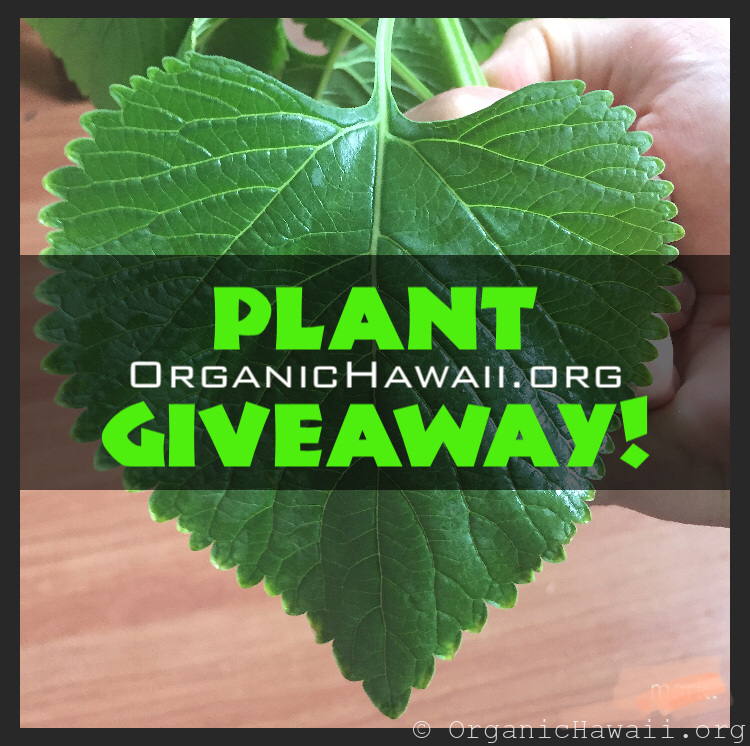
How to Quickly Grow Food and Start a Successful EMERGENCY Garden
Learn how to start a successful food garden quickly and efficiently. Emergency gardening is not a new concept. For example, during WW2 Americans were encouraged to start “Victory Gardens” in order to be more self-reliant in case of food shortages.
It’s not hard to stock up on packaged “emergency food,” but lets face it – there’s no substitute for fresh, organic, wholesome, homegrown food.
With the recent events surrounding COVID-19 and it’s effects on society, many people are turning to “Pandemic Gardening” for two main reasons.
First, people have more time on their hands due to job loss or lockdown orders to stay at home. And the other reason is food security and self-reliance.
Nobody likes seeing empty shelves in grocery stores (due to hoarding). Nobody likes the idea that their favorite food item is out of stock due to supply chain problems.
Additionally, living in the middle of the Pacific Ocean presents Hawaii residents with other types of potential emergencies like hurricanes, storms, and tsunamis, which could all lead to disruption of normal life.
Affiliate disclaimer: As an Amazon Associate I earn from qualifying purchases. You don’t get charged extra and I make a small commission that supports Organic Hawaii. Mahalo!
In this article I will focus on how to grow a successful food garden for self-reliance, food security, and even survival during an emergency such as a pandemic or an unforeseen natural disaster.
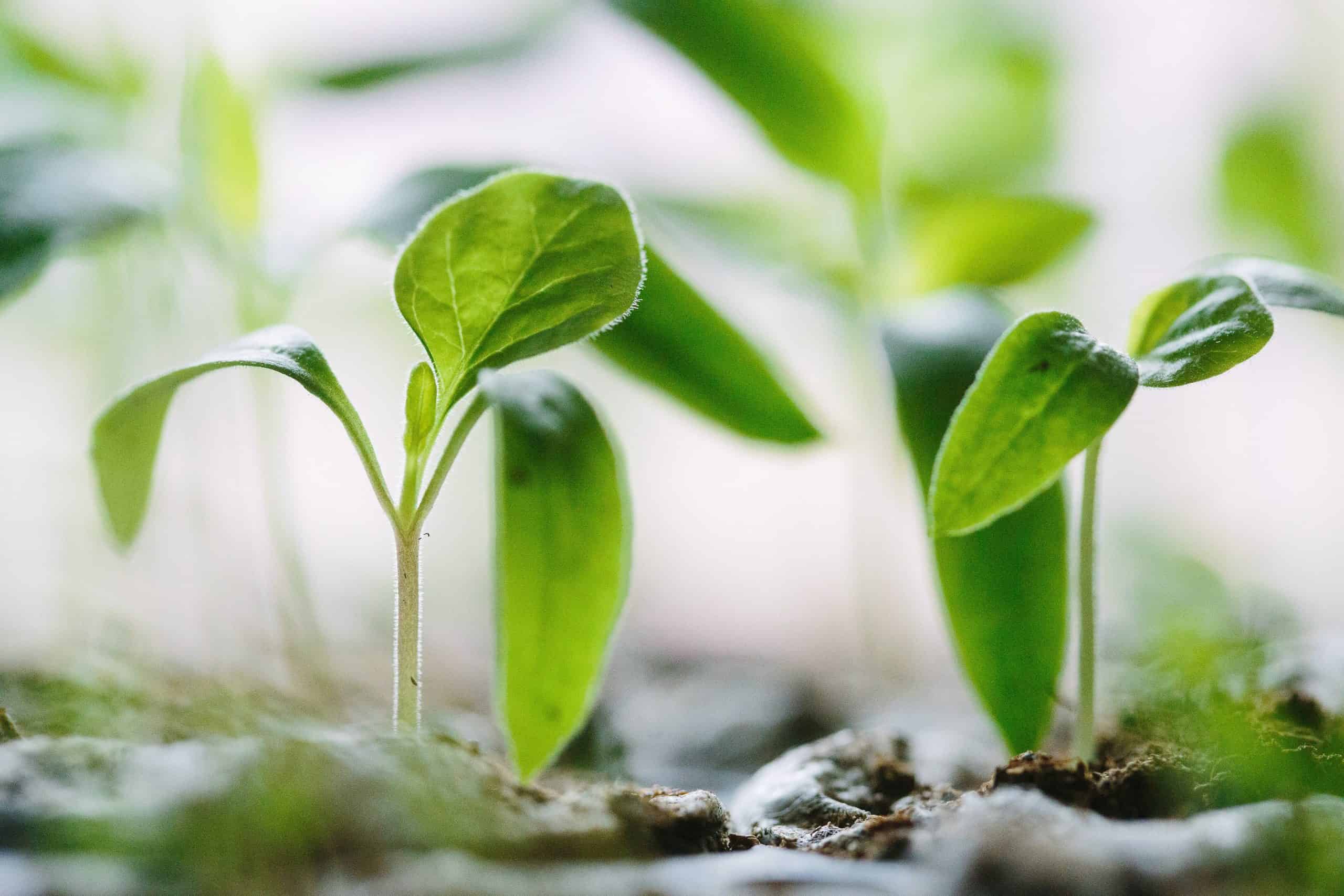
Finding space for your garden
The first question is do you have enough space to grow enough food to sustain you and your loved ones. The quantity of food you harvest will largely depend on the area you have available to grow it.
You can grow your own food even in small spaces and growing some of your own is better than none at all.
Having that said, it’s widely believed you can grow all of your food on as little as 1/4 acre of land for complete self-sufficiency. Of course, this takes planning and there are entire books dedicated to this fine subject like this one and this best seller.
If you don’t have enough space, maybe your neighbor with that large green lawn does. And maybe your neighbor would allow you to use that space in exchange for some of your harvest. Let’s turn boring lawns into exciting gardens!
If you have access to a larger space, it prudent to layout your garden design on draft paper in advance.
In some cultures like Indonesia forest gardening is a way of living. After all, before farming, humanity practiced hunting and gathering wild food grown in the wilderness. When it comes to wilderness survival in the islands, there’s an handy book called Emergency Food Plants & Poisonous Plants of the Islands of the Pacific.
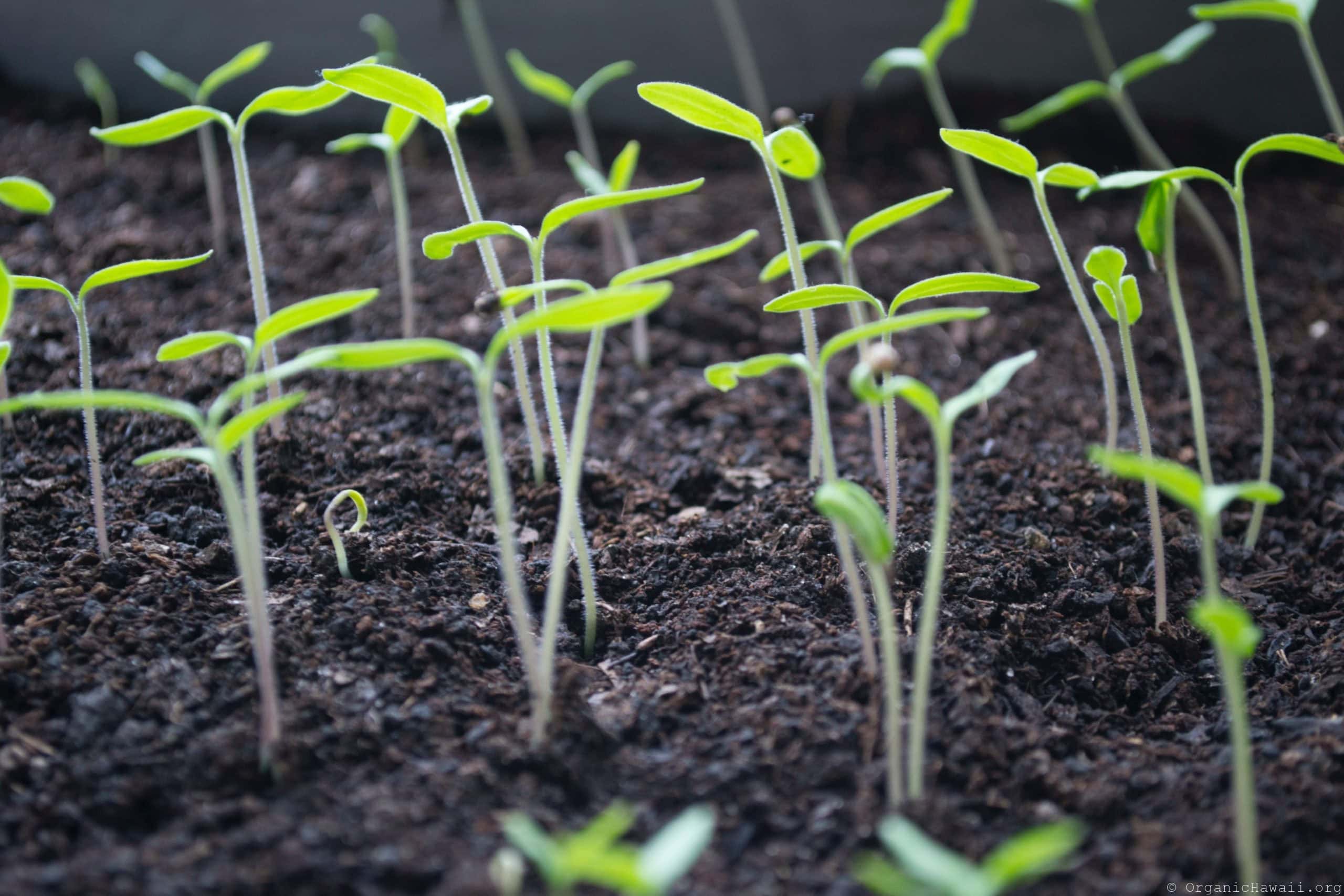
Back to the home garden..
Finding Good Seeds and Starters
Finding good seeds means that:
- Seeds are non-gmo, open pollinated, and preferably organic.
- Seeds are preferably local. So that they are adapted to your local growing environment, including pest and disease resistance.
- Seeds are appropriate for your climate zone.
Many tropical and subtropical plants like dragon fruit, bananas, taro, sweet potato, moringa, etc. can be grown from cuttings or shoots, which speeds up the growing process.
A note on hybrid seeds and plants. Hybrid seeds are usually labeled as F1 (meaning first generation). Hybrid seeds can be organic. Hybrid seeds are bred by crossing different varieties to achieve disease resistance.
The benefit is disease resistance. The downside is future generations (F2, F3..) will not be true to parent (F1), so these genetic traits of disease resistance aren’t necessarily passed down to future generations.
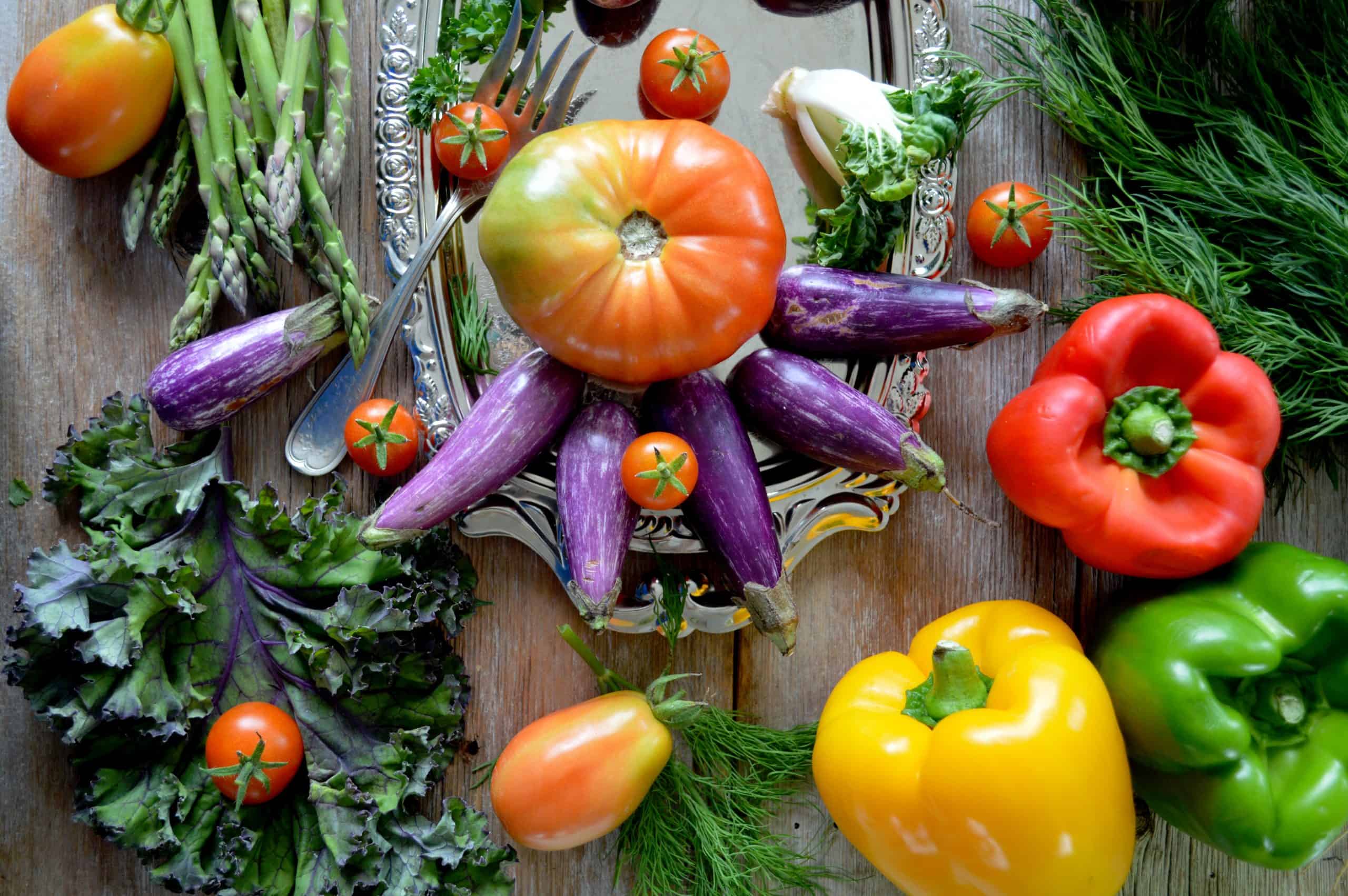
Which Food Plants Grow the Fastest?
Heads up. Gardening means growing “slow food” which is complete opposite of fast food. Plants take time to grow. Patience and care are a prerequisite for gardening success.
When it comes to quickly growing food – it’s about what food you can harvest the fastest.
Fastest fresh food you can harvest are sprouts and microgreens.
Sprouts don’t even require planting in the soil. They can be made in as little as 24 hours by properly soaking the seeds, such as alfalfa, sunflower, beans, etc. Sprouts are by far the quickest “live” food you can “grow” and are packed in nutrition.
Microgreens require planting into soil (or soil-like medium). Microgreens are young leafy greens such as kale, swiss chard arugula, even beets, carrot tops, etc. Once you plant the seeds, microgreens can be harvested in as little as 7-14 days.
Microgreens are also very nutritious, tender, and delicious. They require no cooking, but you have to plant a lot. Microgreens can be planted in flat trays and stacked vertically on shelves to save space.
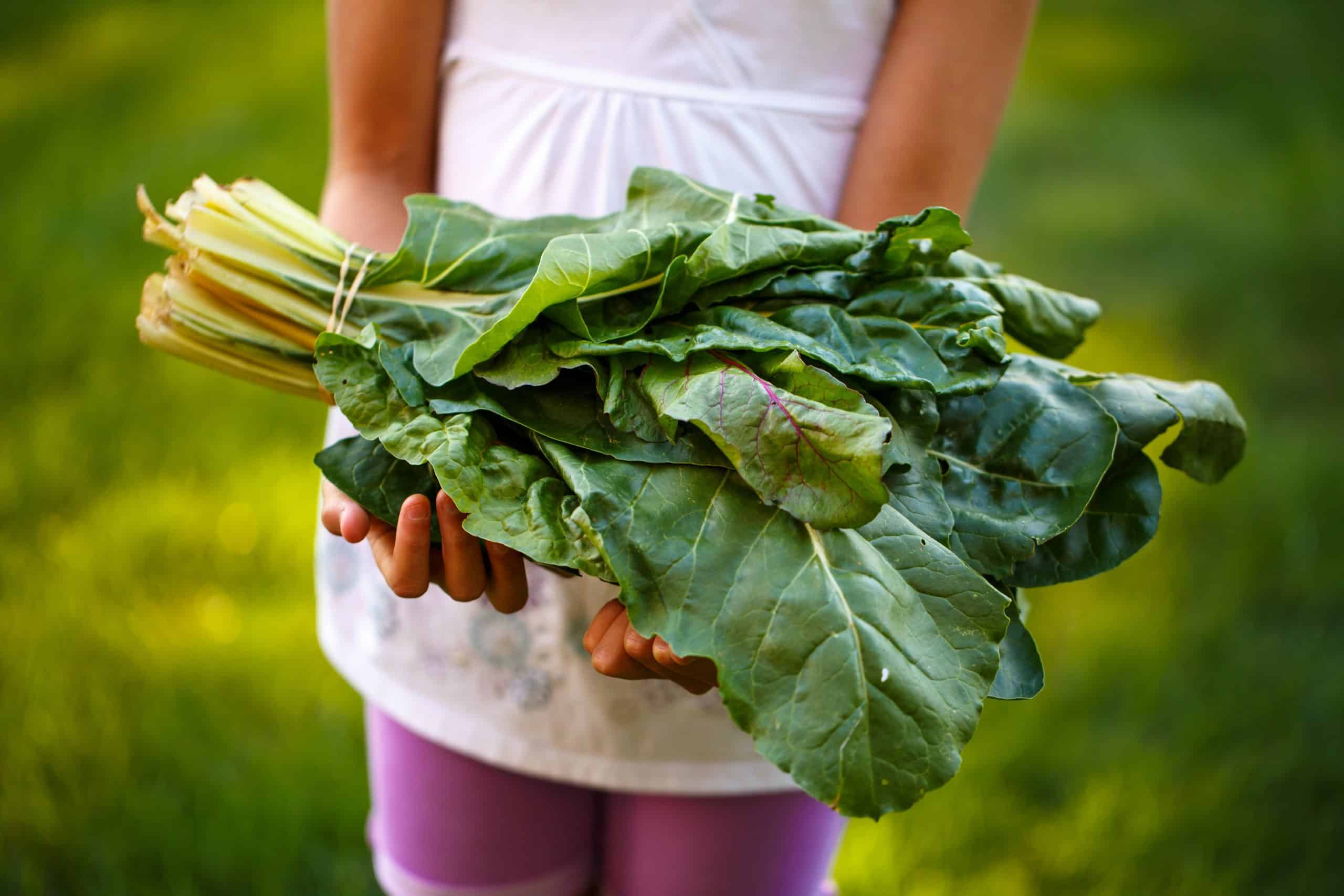
Leafy greens. After microgreens you have your leafy greens. These are basically mature versions of microgreens. Leafy greens can be harvested after about 3-4 weeks from the date of planting. These can be eaten raw in salads, sandwiches, or added to sous, stir-fries, and omelets.
Vegetables. When people think of growing their own food garden first thing that comes to mind is probably garden veggies like tomatoes, peppers, etc. Garden vegetables take about 2-3 months to produce fruit. So, planning and planting in advance is crucial.
Always try to plant more than less, just in case.
To speed up the process, you can buy pre-grown potted vegetable plants. Just make sure they have no disease and are not root-bound. Otherwise they may not grow well. Newly potted plants should be isolated in quarantine for at least one week away from all other plants.
Most vegetables require a good amount of sunshine, especially the Nightshade family such as tomatoes, potatoes, eggplant, and peppers – ideally at least 6 hours a day.
Fruit trees by far take the longest to produce. Depending on variety it can take as little as 1 year up to 8 years! Grafting speeds up fruiting, but it still takes at least a couple of years for most grafts. The benefit of this long wait is large, lifelong, harvests and hardiness (given that you properly take care of your trees).
Fastest fruit producing tropical plants
The good news is that some fruit trees can produce in as little as about 1 year. These fast producing fruit trees include bananas and papayas. Please avoid Rainbow Papaya, which is a GMO variety. Grow Solo Sunrise instead.
The cool thing about growing your own bananas is that you can grow different varieties. Especially rare, delicious, and nutritious varieties that you’ll never find in a grocery store. This awesome book is highly recommended.
Since we’re talking about quickly growing fruits, here are some more examples of fastest fruit producing tropical plants: fig, dragon fruit (Pitaya – grow from cuttings to speed up), poha berry (Cape Gooseberry), Passion fruit (Lilikoi) grow on wall or fence, Pineapple, and Noni (highly medicinal “canoe plant” and emergency food source).

Creating the Best Growing Environment for your Food Garden
Is it nature or nurture? In gardening it’s definitely both. And creating best conditions for your food garden plants will increase chances of success and decrease chances of set-backs.
Best soil. Start by creating best soil you can. Most plants don’t like clay soil. Most plants don’t like sandy soil. Most food plants like nutritious soil that is well-draining, but can also hold moisture and is dark in color.
Most plants like the soil’s pH to be somewhat neutral, but some like it more acidic or alkaline. To find out your soil’s pH and essential mineral content you can simply do a soil test.
Mixing in organic compost and some all-purpose organic fertilizer is a great way to make poor soil much better. I usually mix it at a 1 to 1 ratio of compost to poor soil. Adding organic worm castings is another excellent way to make your food plants grow better.
Deep soil. Most food garden plants like deep rich soil. A popular way to create depth is by using planting boxes and raised beds. This also elevates your plants above the ground level, making it harder for bugs to get to your plants. A spading fork and this tool are very handy at mixing and breaking up soil. Aim for at least 1 foot depth.
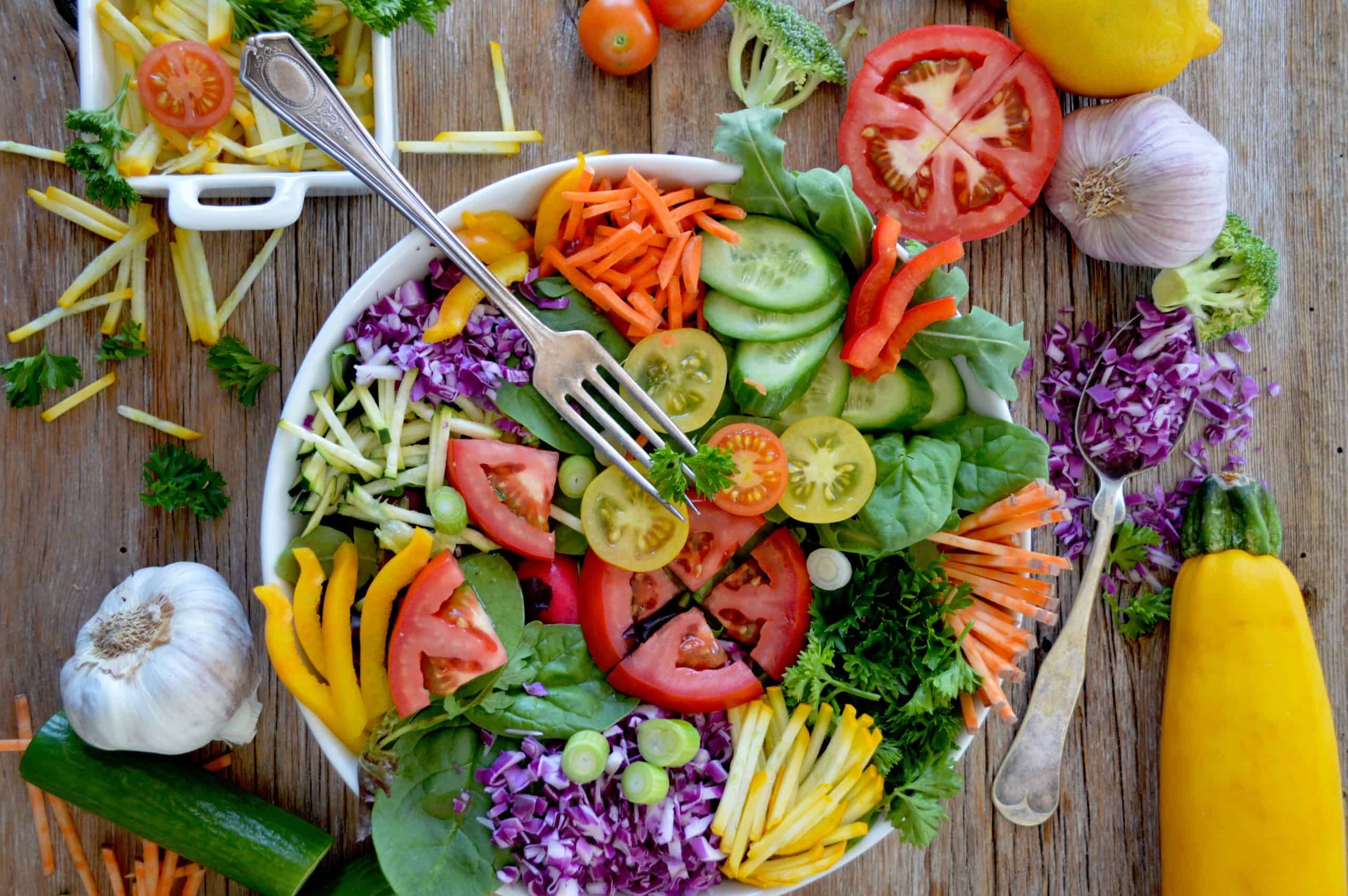
Best seeds. As mentioned earlier, start with best seeds suited for your local growing environment. Or plant healthy pre-grown potted plants to speed up the process.
Many tropical plants can be grown from cuttings i.e. taro, bananas, moringa, sweet potato, etc. This speeds up the growing process.
If you’re starting from scratch I recommend doing both, since most food garden seeds take at least about 1 week to sprout. And from then it’s still a long time until harvest.
Getting cuttings and pre-grown established plants will instantly lively up your new garden and make it more exciting to look at. Plus you can harvest pre-grown plants and cuttings sooner.
Annual vs. perennial. Annual plants only live for about 1 year (or one growing season), while perennial keep on living. So, it important to know which of your plants are annuals that way you can harvest on time, save the seeds, and replant in advance.
Sunshine vs. shade. If you want your food pants to thrive you have to provide them with optimal sun or shade requirements. Think where those locations are in your new garden in advance, according to the type of plant to avoid placing them in the wrong spot.
Generally, many subtropical and tropical plants prefer full sun, this includes the nightshades. Leafy greens, however may get burt by too much Hawaiian hot sun. So part shade may be appropriate to avoid burning those plants.
Optimal watering. In Hawaii, most plants like to be watered daily, especially in the Summer, but overwatering can create root rot and other fungal diseases. It’s best to water in the morning and/or evening.
Watering will also depend on how much rain your location receives. Some plants like aloe, can be easily killed by regular watering, so more is not always better.
Watering with purified water is better because a garden water filter reduces the amount of toxic chlorine, toxic heavy metals, and other contaminants that would otherwise end up in your soil and your plants.
Chlorine is known to kill off beneficial bacteria in your soil, which is not good and certain plants uptake toxic heavy metals from the soil more so than others.
Companion planting. It’s well established that certain plants like to be planted next to each other, while others grow poorly together. Some plants, like mints and certain herbs, actually help repel bugs from their companion plants like tomatoes. You can use companion planting tables to see which plants to plant together and which not to.
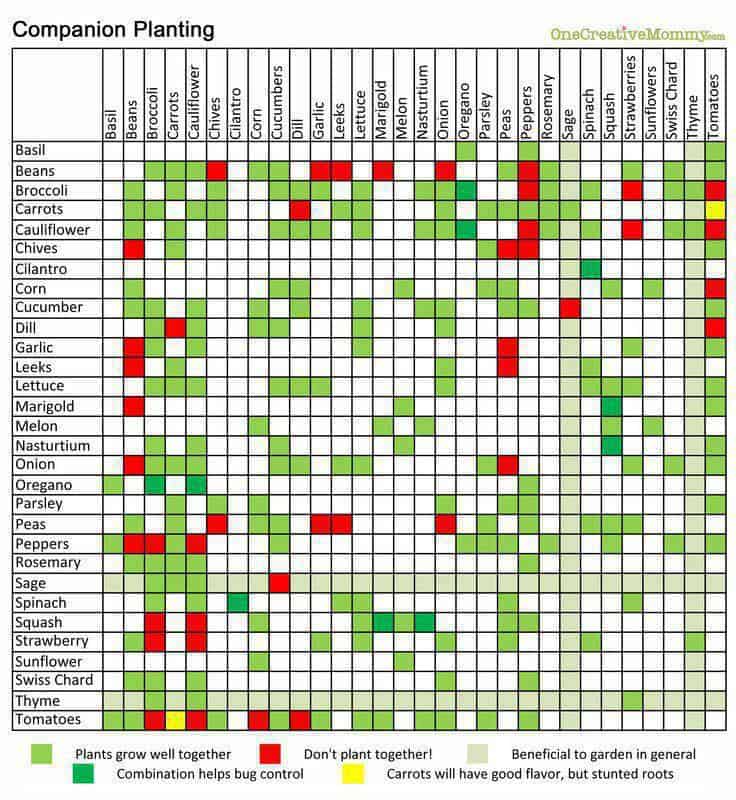
Pollinators and other good bugs.
“Is it a friend or foe?” – is common question in gardening circles. Not all bugs are bad. Some insects, like the pollinators are essential. Pollinators include bees, butterflies, but other insects that pollinate your plants’ flowers, ensuring fruit production.
Not all plants are self-pollinating, so attracting pollinators is important by planting what attracts them. For example, bees absolutely love basil plus it’s a great culinary herb. Planting a nice variety of flowers will not only brighten up your garden, but will also attract the pollinators.
Without the pollinators we’d have to pollinate many plants by hand, which is very labor intensive, as you can imagine.
Other bugs are beneficial because they feed on the bad bugs that destroy your plants. These beneficial insects include wasps, lady bugs, and lacewings.
Dealing with bad bugs, pests, and viruses.
There are many books dedicated to this subject. But to keep it simple, I recommend to at least get Diatomaceous earth (DE) and organic Neem oil. DE is great for many bugs such as ants, roaches, cutworms, etc.
You can even make your own DIY organic bug spray using basic ingredients and essential oils.
Neem oil is great for different kinds of bugs that have soft bodies and waxy coating like aphids, mealy bugs, mites, and white flies, but it’s actually very versatile for other plant pests including scale. In this video we talk about benefits of Neem oil in detail.
Slugs are awful and can quickly eat your leafy greens and kill young seedlings. Plus they can carry nasty disease such as the rat lungworm.
Slugs usually come out at night. Introducing ducks or even attracting garden frogs may help. Also using copper tape around your pots or raised beds is definitely worth a try.
Viruses are a bit harder to deal with since they are so tiny, but using colloidal silver on plants and soil is very promising. Colloidal silver is also effective against bacterial and fungal pathogens.

Mulching.
Mulching is adding chopped, dry plant material on top of your soil and around your plants. Benefits of mulching include: water conservation, weed control, and pest control.
Optimal Nutrition for Your Food Garden.
Plants require basic nutrition, as expressed by N-P-K (Nitrogen, Phosphorus, and Potassium). Nitrogen (N) can speed up the growth of your plants, especially leafy greens. However, tToo much N is not recommended during the flowering/fruiting stages, since you want your plant to focus on making fruits, not new leaves.
Plants also highly benefit from other minerals, beneficial soil bacteria, and worms. So, don’t forget to feed your plants every now and then with organic amendments like organic compost, compost tea, composted manures, worm castings, and all-purpose organic fertilizers.
Optimal Nutrition from Your Food Garden.
Humans require three basic food groups for optimal nutrition and health: protein, carbs, and fats. We also require vitamins and minerals. Most food garden plants are low in protein and fats, but high in vitamins and minerals.
However, certain nuts and seeds are actually great sources of both: protein and healthy fats. Plus, they are high in multiple minerals. Without a doubt, sunflower, hemp, and pumpkin seeds are Superfoods that contain generous amounts of the essential magnesium, selenium, Vitamin E, manganese, and zinc just to name a few.
Also, backyard chickens and ducks are a popular option for homegrown protein and organic eggs are an excellent source of choline and essential omega-3 fats. Additionally, they will eat the bad bugs (and slugs) while fertilizing your soil with their manure.
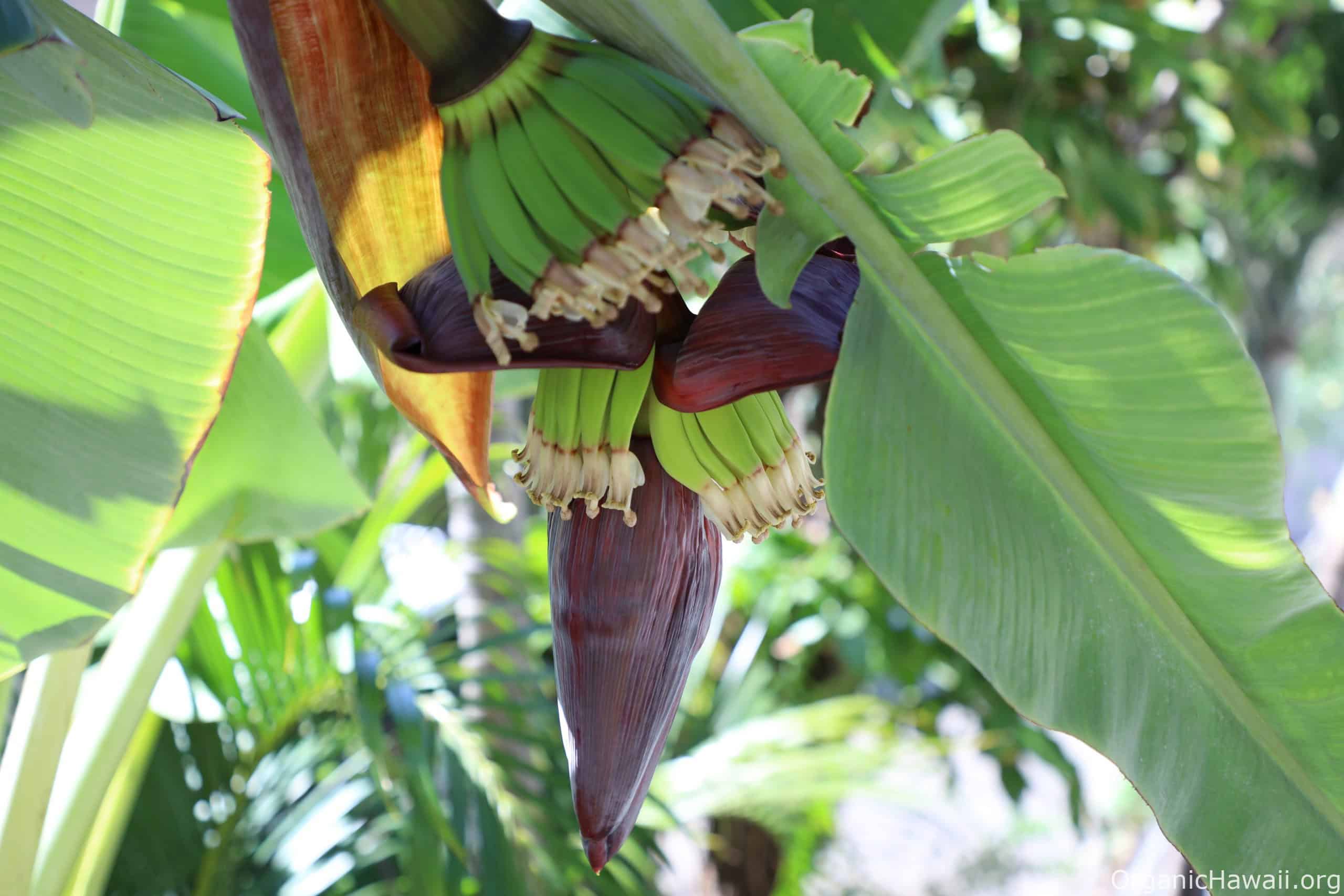
For further reading..
Check out this simple, but crucial guide: “Can I Grow A Complete Diet?” on what exact tropical and subtropical plants to grow for optimal nutrition and self-reliance in Hawaii.
Final thoughts..
If you’re just starting out just remember to be patient. Once your garden is established, it will be easier to care for, requiring minimal time and effort.
Food gardening is about the journey AND the destination. It’s a great form of light exercise, and it’s a meditative process that connects us with our source.
Best of all, growing your own food makes you more self-reliant and independent, while providing you and your family with healthy, ultra fresh, and nutritious food at your doorstep.
Wishing you great success and happy growing!!
15 Ways to Reduce EMF Radiation for Better Health
EMFs are Electro Magnetic Frequencies. They are invisible to us, yet we are saturated by them anywhere we go. EMF-free or low EMF spaces are hard to find, but it’s doable.
5G, 4G, 3G, LTE, cell phones, Wi-Fi, Bluetooth, microwaves, mobile base stations (cell phone towers), and smart meters are some examples of (HF) high frequency EMF radiation.
Bad electrical wiring (especially ungrounded wires), certain electrical appliances, and overhead power lines are some examples of ELF (Extra Low Frequency) and VLF (very low frequency) EMFs.
Are there naturally occurring EMFs?
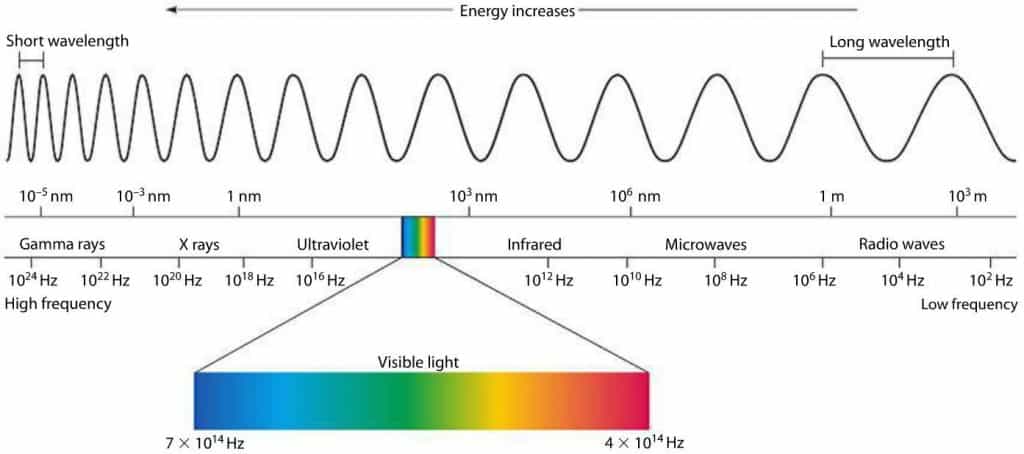
Yes, there are. The reality is that Humanity has evolved over hundreds of thousands of years alongside natural EMFs such as UV (ultraviolet radiation), infrared radiation (both produced by the Sun), Schumann resonances aka the “Heartbeat of Our Planet”, and geomagnetic storms produced by the Sun’s solar cycles during Coronal Mass Ejections.
For the most part, our planet does a wonderful job at protecting us from these naturally occurring EMFs. And some may be even beneficial to our well-being, such as the Schumann Resonance.
The Schumann Resonance oscillates at about 8 Hz (Hertz), and coincides with our Theta-Alpha brainwave activity – a therapeutic state of being: a meditative state of calm, reflection, creativity, relaxation, enhanced learning, and even helps with depression.
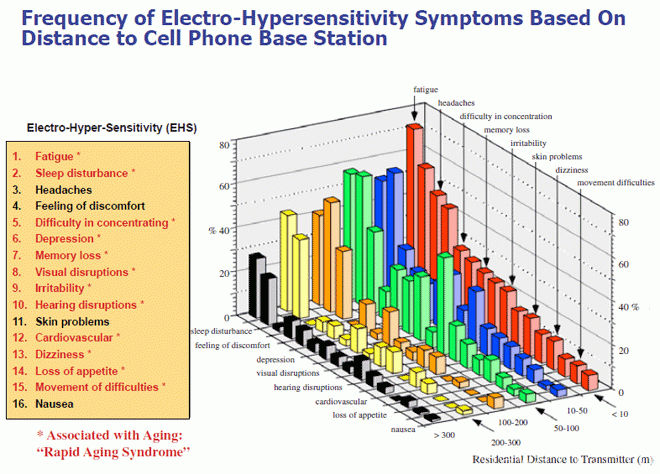
On the other hand, unnatural EMFs have been linked to various health conditions, as documented by the Bioinitiative Report.
Therefore, reducing and eliminating unnatural EMFs is a health conscious step for a healthier life.
Medical Disclaimer: If you have a medical condition please speak to your doctor regarding any health concerns. Information in this article is not a prescription or medical advice. Affiliate disclaimer: As an Amazon Associate I earn from qualifying purchases. Thanks for your support.
15 ways to reduce or eliminate harmful EMFs around you
In short, harmful EMFs (including 5G) can only be reduced by: turning off the source of radiation, increasing physical distance from the source, or using Faraday Cage type of physical barriers to block or reduce EMF radiation. There’s no known device or pendant that effectively blocks radiation around you, although research into scalar waves is interesting.
1. Find a “Low EMF” home, work, and school.
Location, location, location..
We go in great detail in this article on how to do just that. But in summary, the further away you are from the source of EMF radiation (especially cell phone tower, 5G tower, base station, or neighbors’ Wi-Fi, smart meters, even your own cell phone) – the less high frequency EMF radiation.
The only way to exactly know how much EMF radiation is around you is to measure it. We personally use Acousticom 2 and PF5 Power Frequency Meter. This EMF meter seems pretty cool too.
2. Turn off your Wi-Fi and Bluetooth when not in use. Hardwire, if possible or increase physical distance away from it.
Reduce and eliminate your own EMF sources. This is by far the easiest way to reduce EMFs that you have direct control over.
Turn off your Wi-Fi and Bluetooth when you sleep and when it’s not being used. Move it out of the bedroom or another area where you spend a lot of time in close proximity.
Having a Wi-Fi router that allows you to easily turn off Wi-Fi signal without turning off the wired Internet is very practical. We’ve personally tested and used this Netgear Wi-Fi router. We discovered that you can actually significantly reduce it’s Wi-Fi radiation by easily removing 1 to 3 of its antennae while still getting signal. This is practical for areas that don’t need large Wi-Fi coverage.
Disabling bluetooth in “smart” devices (including cars) will also reduce EMFs around you.
A lot of people unknowingly have their Bluetooth and Wi-Fi turned on on their mobile devices. Even though they are not using it, those settings create extra EMF radiation. Check your settings to make sure your Wi-Fi and Bluetooth is completely of when you aren’t using it.
Hardwiring your Internet router using ethernet cables is best, because it eliminates the need for Wi-Fi altogether, while boosting your internet speed for your computers.
The downside of completely hardwiring your Internet router is the fact that your cell phones and other mobile devices will have to be on mobile data, which creates a bit more EMFs from those mobile devices.
A compromise solution is to hardwire what you can, while having Wi-Fi available for your mobile devices. This Wi-Fi router allows you to do just that.
3. Increase physical distance between you and your cell phone.
Especially, avoid holding your mobile phone next to your ear (brain), heart, reproductive, and other vital organs. Use speakerphone or wired headphones instead.
“Holding your mobile phone next to your head increases you chances of brain cancer!”
Source: Study
Don’t sleep next to a cell phone, unless it’s on airplane mode or completely off. If you have to keep it on during the night, simply put it as far as possible from your body, but close enough so you can hear it if it rings in the middle of the night.
Also, avoid having your cell phone in close contact with your body, especially vital organs. This includes: front pockets, back pockets, chest pockets, bras, fanny packs, etc. unless it’s on airplane mode. Women can use purses and guys can use cargo pockets, or handbags, or anything else that creates more distance from vital organs.
There are also EMF blocking cell phone cases.
4. Reduce mobile phone time when driving.
Cell phones radiate more EMFs when you’re driving because they are forced to always look for a new mobile base station (cell phone tower) to stay connected, as you drive around.
Also, your cell phone has to work (radiate) slightly harder when you’re inside the car because your car is a weak EMF barrier, which your mobile phone tries to overcome to stay connected, so it radiates more.
6. Stop using wireless headphones, bluetooth headsets, and “smart watches.”
Wireless headphones, headsets, and “smart” watches create convenience (of not having wires) at the expense of exposing you to EMF radiation. Wireless headphones and headsets rely on wireless Bluetooth technology to stay connected.
Smart watches usually rely on mobile data and/or Wi-FI to stay connected. The trouble with these devices is that the person is actually wearing it, so there’s no physical distance to reduce the EMFs these wireless devices produce.
Smart watches, wireless headsets, and earphones can easily be substituted with their wired counterparts to completely eliminate EMFs radiating from them. For many years we’ve been using these excellent Sony headphones that function as a headset and offer superb sound quality for lovers of music.
8. Use Wi-Fi instead of cellular data whenever possible.
Mobile devices connected via cellular data instead of Wi-Fi tend to create more EMF radiation. This is likely due to the fact that cellular data relies on connecting to distant mobile base stations, rather than nearby Wi-Fi. Therefore, mobile devices have to work (radiate) harder, increasing EMFs.
9. Use wired connections instead of wireless whenever possible.
Wired devices such as keyboards, speakers, printers, microphones, etc. don’t radiate high frequency EMFs, since they don’t rely on Bluetooth or Wi-Fi. Wireless DECT phones should be replaced with wired telephones too.
Switching to wired versions of these appliances will eliminate high frequency EMFs. Just don’t forget to disable “wireless mode” after wiring.
10. Stop using the microwave oven.
We’ve completely stopped using the microwave oven about two decades ago. We consciously choose to forgo the convenience of quickly “nuking” our food in favor of nutrition and health.
Microwaving food not only destroys it’s nutrition, while exposing it (and us) to toxic packaging materials (which are usually nuked too), but it also creates a very high EMF environment in the kitchen. Although, microwaves are designed to contain most of the EMF radiation, it can still leak through.
Not surprising, since the microwave oven technology has it’s roots in WW2 microwave weapons technology.
To go around the microwave we’ve been relying on simply warming up food on the stovetop or the oven. A toaster oven is also a great substitute to the microwave.
11. Download music and videos instead of always streaming.
When you’re streaming music or videos you are increasing your exposure to EMF radiation. This is especially worrisome for kids who are glued all day to their iPads, tablets, or phones. Kids and babies absorb more EMF radiation.
To go around streaming – download music and videos in advance. Nowadays apps like Amazon Music (try Amazon Music Unlimited Free Trial), YouTube Premium, and Spotify Premium allow you to download music and videos to your mobile device.
It’s a great feature, which allows you to put your mobile device on “airplane mode,” thereby completely eliminating high frequency EMFs. As health-conscious parents we use this feature as much as possible not only for our child, but for ourselves, as well.
12. Opt-out of “smart” meters.
Smart meters are known to be constant sources of dangerous EMF radiation. They are usually installed by the electrical company to measure electrical use and wirelessly send data back to the company.
If it’s already installed some people put a smart-meter shield over it. The problem is that electrical company might take it down.
So if a smart-meter shield or moving is not an option, then a Faraday cage type of “shield” inside the home may need to be implemented. This type of smart meter shield is usually composed of large rectangular piece(s) of solid metal (such as copper) or wire mesh placed on the wall(s) near the smart meter. Please consult a licensed electrician for safe instillation.
13. Inspect for Extra Low Frequency (ELF) EMF radiation.

This is often an overlooked point, due to overemphasis on high frequency (RF) EMFs (i.e. from mobile devices, etc.)
However, ELF radiation has been linked to severe health conditions such as childhood leukemia (blood cancer). – Source
Childhood leukemia mostly occurs in children ages 2-5 years old. When I found this out I was alarmed because my child was in this age group and our rental unit had ELF radiation averaging 8mG and as high as 20mG!
I used the PF5 Power Frequency Meter to measure it.
Considering that the average home has ELF radiation in the range of 0.5 to 1mg and the fact that the risk of childhood leukemia increases at levels of 1mG and above I was shocked. No pun intended.
I suspected that there was an ungrounded or improperly wired stray electrical current that was being picked up and dispersed by the metal framework inside of our unit’s flooring and walls.
In time, we ended moving out of that unit into a home where ELF EMF radiation was within normal range. I definitely felt relieved and re-lived, since ELF EMFs clearly have an effect on adults, as well. And it’s not just “in the head.”
But the reality is that basic non-wireless electrical devices produce ELF EMF radiation when in use. This could be the fridge or the blender, the heater or the convection stovetop.
The good news is that ELF radiation from these appliances drops off significantly with distance. Meaning only a distance of a few feet makes a huge difference in exposure levels.
Having that said, “some close-proximity” devices like ungrounded laptops are a concern. So properly grounding your laptop (or another ungrounded appliance) will make a huge difference.
It’s easy to ground a MacBook laptop using this type of cable. It basically needs to have a third prong for grounding. Plugging in small ungrounded appliances such as essential oil diffusers, air purifiers, etc. into grounded extension surge protectors will reduce their (ELF) EMF radiation.
Also, unplugging your laptop power adapter when it’s fully charged and running it on battery power will reduce these ELF EMFs.
14. EMF-proof your house.
For those living within several blocks distance to a cell phone tower and when moving is not an option, EMF proofing would be the only solution to reduce outside EMF exposure.
EMF proofing the house basically entails turning your home into a Faraday Cage to a degree. It all depends on what degree.
Most people wouldn’t want to live in a Faraday Cage type house because they want their cell phones to work. A full on Faraday Cage would block out all or most EMFs. This is too extreme for most people, but not all people are like most.
Having that said, properly installed copper roofs, EMF blocking paint, fine wire mesh made out of aluminum or copper, and special EMF blocking fabric would reduce high frequency (RF) EMFs inside your home.
The hard part is blocking ELFs coming from electrical substations and overhead wires (in the street). ELFs can penetrate the above mentioned materials, whereas microwaves and RF (radio frequencies) are effectively reduced.
ELFs (Extra Low Frequency) radiation needs magnetic type of shields in order to be reduced or blocked.
15. Spend more time in Nature.
Cities are inundated by harmful EMFs, so to escape this environment we must spend more time in nature away from the city. Plants and trees reduce and block EMFs plus they produce fresh oxygen.
Nature also psychologically breaks down the hyper-structured, artificial, rectangular, “box-like” monotony of the city vibe.
In this article we went out and measured EMFs throughout Honolulu in search of a Low-EMF-Environment. Our findings confirmed that there are significantly less or no harmful EMFs when we are surrounded by Nature.
The sad reality was that in August of 2020 the State of Hawaii made going to Nature mostly illegal due to COVID-19 by closing all public hiking trails, beaches, botanical gardens, community gardens, parks, and playgrounds while keeping shopping malls open.
Luckily this sad reality (above) is over, but there’s another threat to our open spaces that needs your urgent input.
“5G ROLLOUT IN U.S. NATIONAL PARKS”
– URGENT: please sign petition to STOP 5G in U.S. National Parks
In a unimaginable move, the U.S. National Parks and Forests are now a target of the 5G rollout. This is simply unnecessary and unacceptable. Our natural spaces must remain the way nature intended it – EMF free.
Please spread the word and sign the petition. Mahalo!
How to Add Magnesium to Plants, Veggies, and Soil using Epsom Salt
Magnesium (Mg) is an essential mineral for human health and plant health.
In humans Mg is responsible for over 300 enzymatic reactions and is a required mineral for proper heart function, good mood, muscle relaxation, better sleep, and more.
In plants Magnesium is required for proper photosynthesis. Without Magnesium plants cannot properly capture Sun’s energy. Now that’s important! It also helps plants uptake Phosphorus – a critical plant nutrient.
Medical Disclaimer: If you have a medical condition please speak to your doctor regarding any dietary changes or supplements. Information in this article is not a prescription or medical advice. Affiliate disclaimer: As an Amazon Associate we earn from qualifying purchases. You don’t get charged extra and we make a small commission that supports Organic Hawaii. Mahalo!
Lots of people are deficient in Magnesium because their diet and lifestyle don’t provide enough Mg and/or leach it out of the body.
Therefore, it’s crucial that the food we eat provides sufficient daily Magnesium levels. By the way, some of the highest sources of organic Magnesium in food are found in organic cacao, organic sprouted pumpkin seeds, organic hemp seeds, and organic sprouted sunflower seeds.
In supplement form Magnesium is all bout absorption. We prefer and supplement with either Pure Magnesium Glycinate or Magnesium Citrate.
So how can we safely, easily, and quickly add Magnesium to our garden plants, like veggies, leafy greens, and our soil?
The answer is: Epsom Salt aka Magnesium Sulfate!
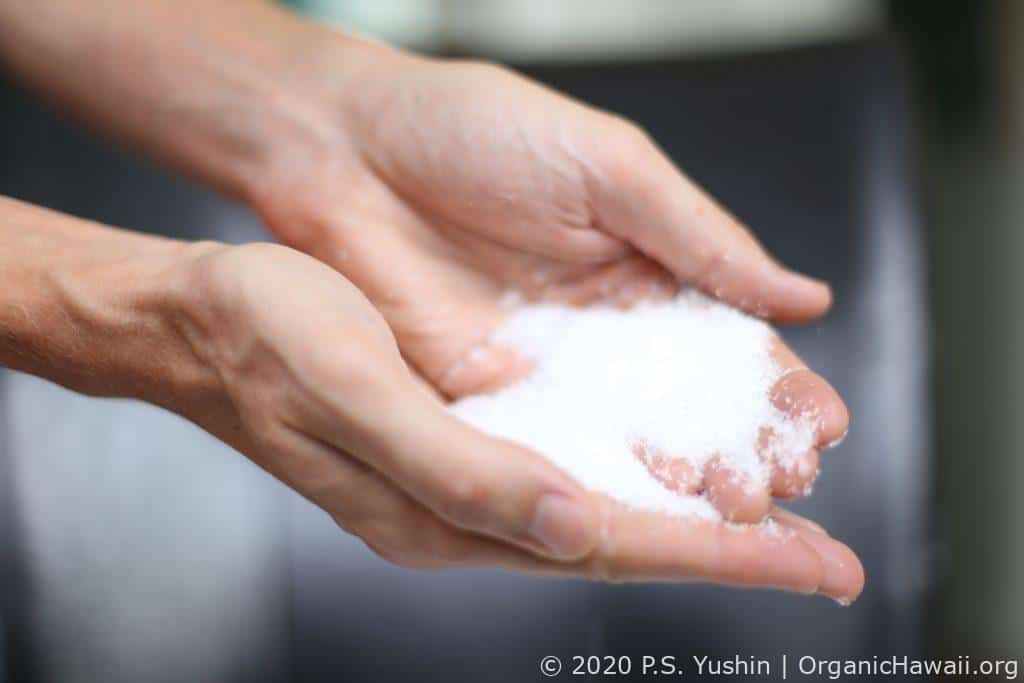
Epsom Salt (Magnesium Sulfate) is made from about 10% Mg and 13% Sulfur (S). It’s widely known as an additive for warm foot soaks and baths, but it’s actually a great fertilizer part of Organic Gardening and Organic Farming, especially if it’s OMRI listed Epsom Salt.
Deposits of Magnesium Sulfate commonly occur naturally at the bottom of dry lake beds or they can be created by combining essential minerals. Epsom Salt does not contain actual “salt” (sodium). It’s called “salt” due to it’s crystalized appearance.
As a matter of fact, it’s listed as an organic fertilizer in two of our very own books on Organic Gardening: Organic Gardening for Dummies (p.91) and 1519 All-Natural All-Amazing Gardening Secrets (p. 173 and p.209). Epsom Salt is especially recommended for roses, nightshades such as potatoes, tomatoes and peppers, citrus, carrots, and greening up plants including the lawn.
More so, according to The Epsom Salt Council: “Epsom salt – actually magnesium sulfate – helps seeds germinate, makes plants grow bushier, produces more flowers, increases chlorophyll production and deters pests, such as slugs and voles. It also provides vital nutrients to supplement your regular fertilizer.”
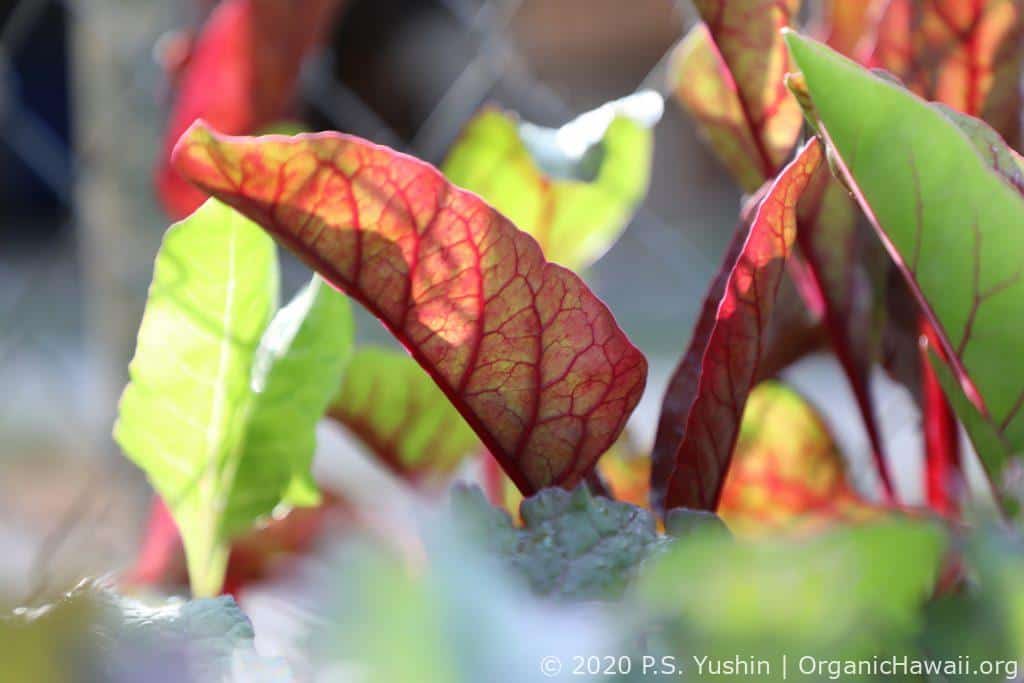
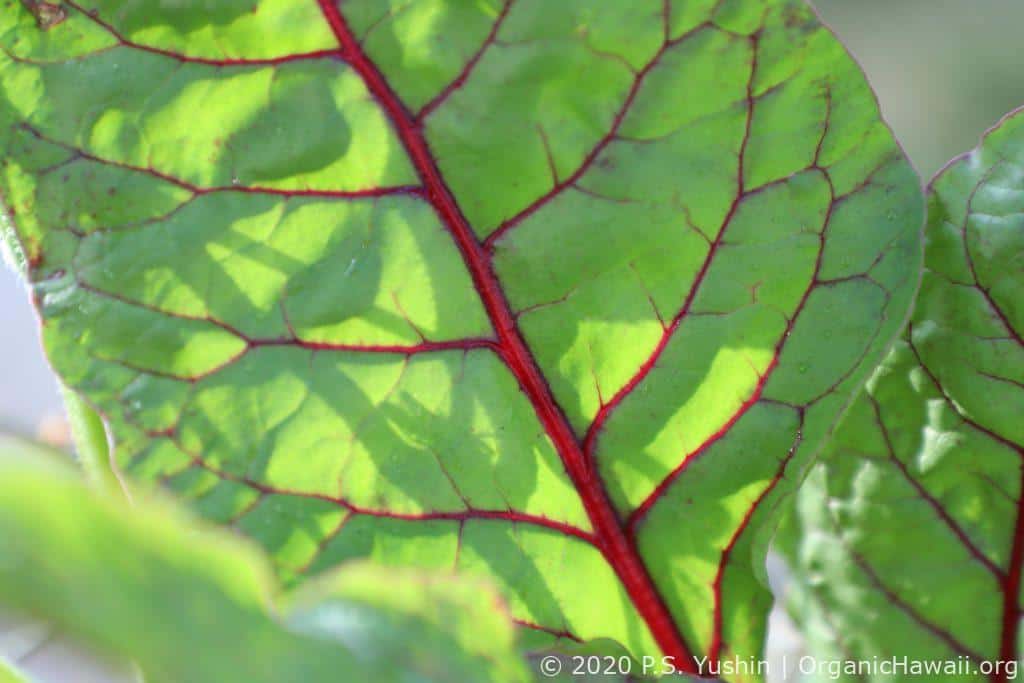
From our own gardening experience Epsom Salt also adds vibrant red color to red stemmed Swiss Chard and purple color to Red Russian Kale – a sign that leafy greens benefit and readily absorb Magnesium sulfate.
Magnesium Sulfate is nearly pH neutral, which is great since it won’t alter your soil’s pH. It’s also water soluble meaning that it easily and quickly dissolves in water making it’s application quick and easy.
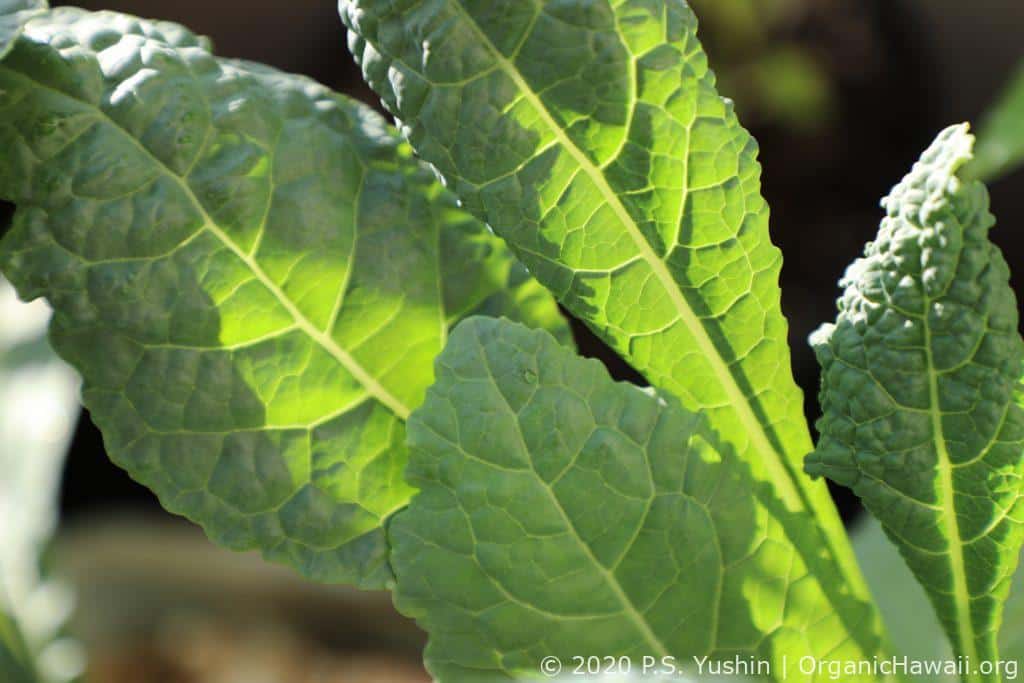
How do you know your soil needs Magnesium Sulfate (Epsom Salt)?
Generally, the surest way is to have your soil tested in a lab to see if there is a Magnesium and/or Sulfur deficiency.
However, not everyone is willing to test their soil due to cost or time constraints. So for those who don’t want to test their soil the following can be used as a general guide.
- If your plants look healthy, then you probably don’t need it. (If it’s not broken don’t try to fix it.)
- Are your plants are turning yellow, then you probably DO need it.
- Do you already fertilize with a fertilizer that has Magnesium, then you probably don’t need more of Mg. Check the back label for minerals in your fertilizer.
- If you live an an area with heavy rainfall, then you probably DO need it since Mg is water soluble with time it washes out of the soil, especially sandy soil.
- Even if you don’t live in an area with high rainfall, but you do water your plants on a normal basis, then your plants probably do need it every now and then.
- Magnesium doesn’t occur out of the blue in regular or poor soil, so it should be added to soil in one way or another.
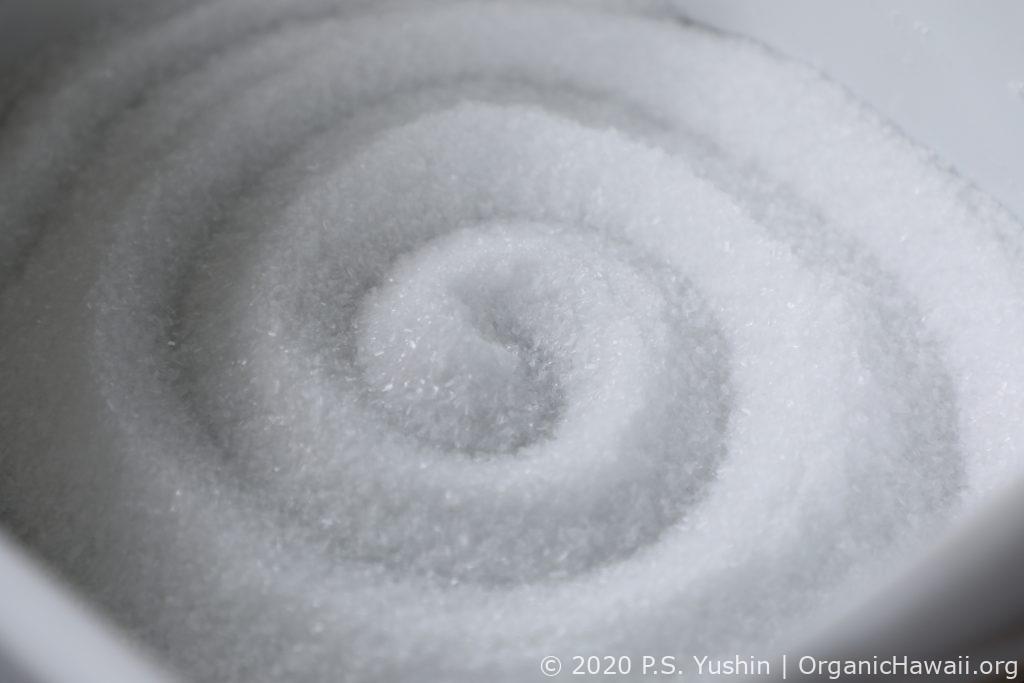
How to apply Epsom Salt (Magnesium Sulfate) to fertilize your plants?
There are three ways you can fertilize your garden with Epsom Salt.
Method 1: Foliar spray – spray the leaves with Epsom Salt
Step 1: Mix 1 tbs. (tablespoon) per 1 gallon of water until dissolves.
Step 2: Add the mixture to a spray bottle or a pump sprayer.
Step 3: Spray the leaves of your plants in the early morning or evening when direct Sun is not hitting them, once a week.
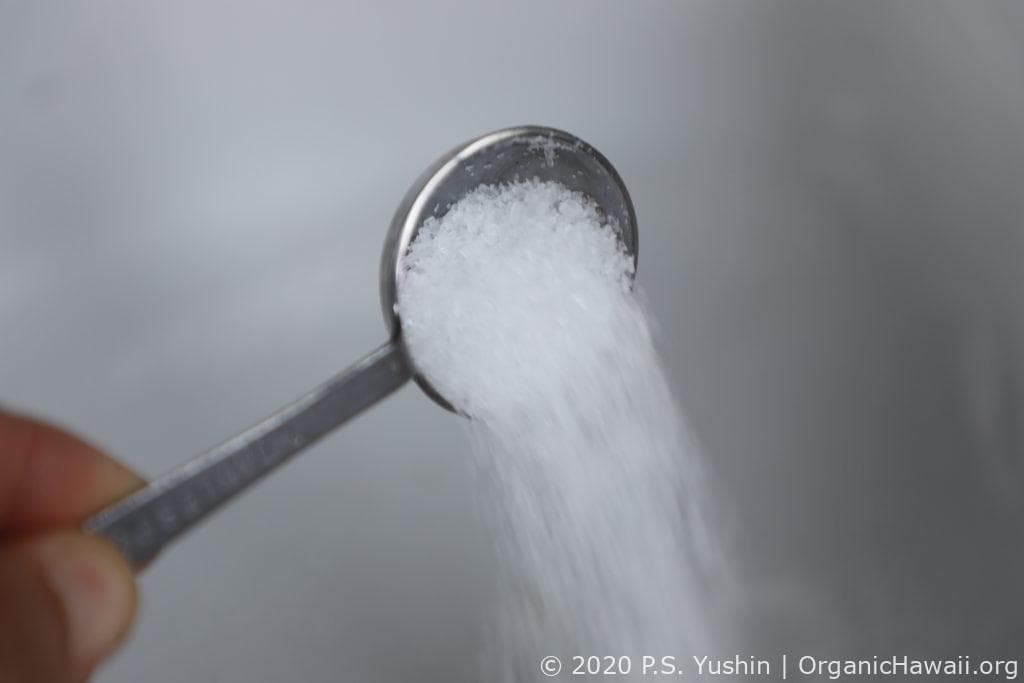
Method 2: Water the soil with Epsom Salt
Step 1: Mix 1 tbs. (tablespoon) per 1 gallon of water until dissolves.
Step 2: Add the mixture to a watering can.
Step 3: Water the soil under your plants.
Method 3: Sprinkle Epsom Salt onto Soil
Step 1: Follow manufacturer’s directions to measure the right amount needed. Usually 1tbs. per 1 foot of plant height.
Step 2: Sprinkle directly onto soil around the plant’s drip line.
Step 3. Water thoroughly.
Caution: Don’t overuse Epsom Salt because it contains sulfur. Although sulfur is essential to plants (especially the Allium family like onions and garlic, too much sulfur may kill beneficial (and bad) bacteria and microorganisms in your soil.
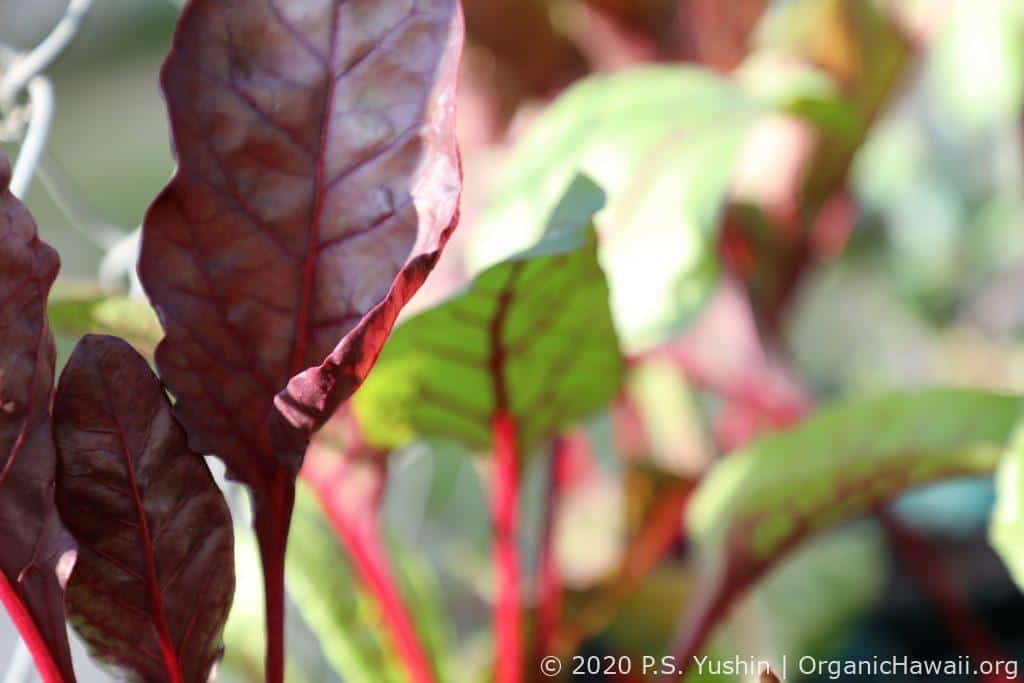
Now that you know how to easily and affordably add Magnesium to your garden plants, veggies, leafy greens, lawn, and soil try it out and let us know your experience in the comments below.
Mahalo and happy organic gardening!
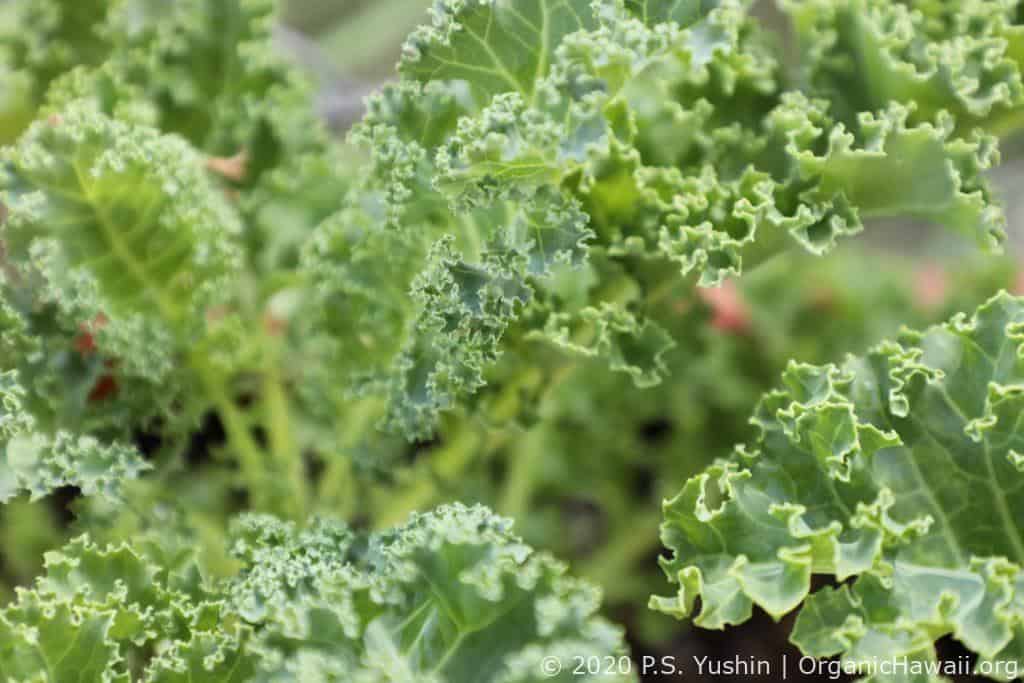
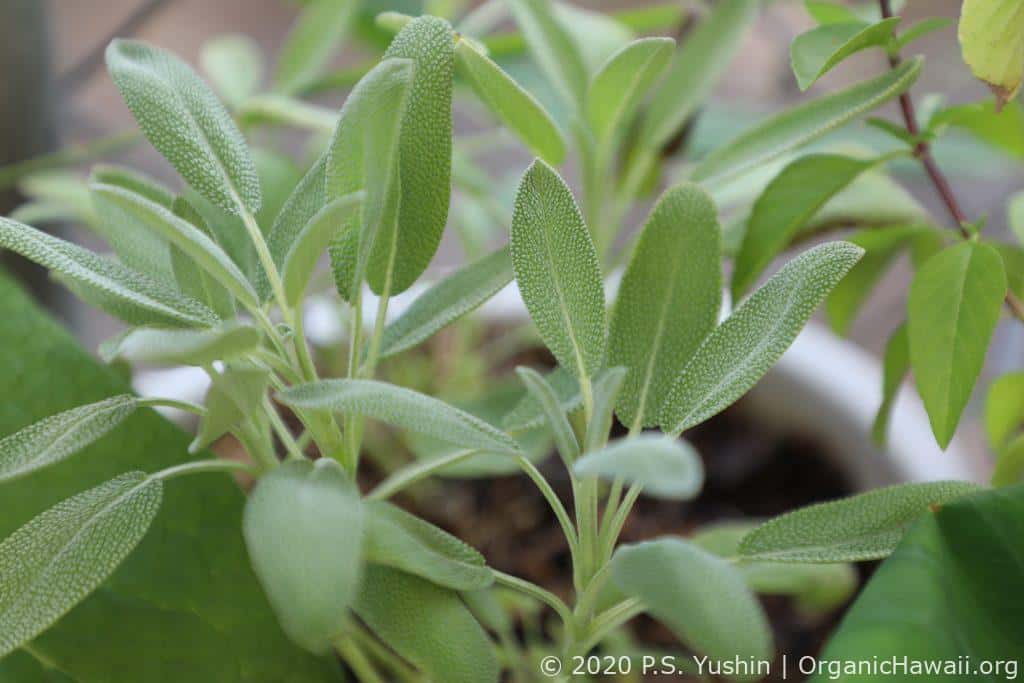
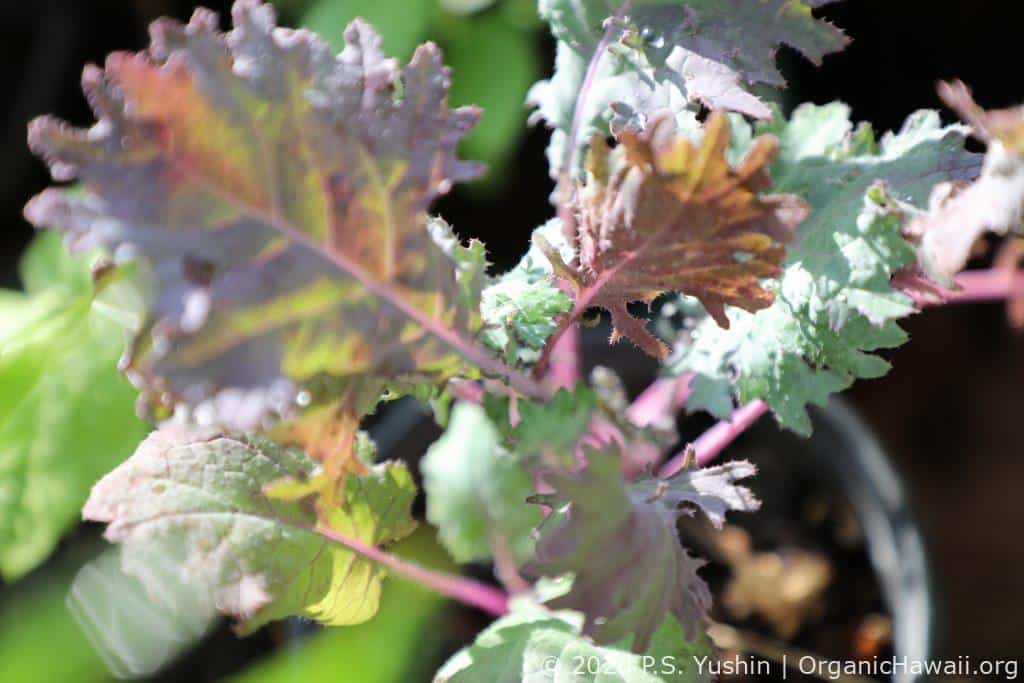
How to Make BEST NONI JUICE at Home: Easy Step-by-Step Guide
One of the great things about living in Hawaii (or another place where Noni grows) is that you can make your own raw organic Noni juice! Noni juice is easy to make (and has a pleasant taste) if you do it right. Very healthy for a variety of health issues. A true tonic.
Noni is simply amazing!
Noni also known as Indian mulberry and Morinda citrifolia is an amazing fruiting tree native to India, Malaysia, Indonesia, Philippines, and Polynesia including Hawaii. It can be easily grown in tropical and sub-tropical climate.
Surprisingly, Noni is related to the coffee family of plants. And is known to exhibit a mellow, calm buzz to those who drink the juice. Noni contains no caffeine and a multitude of beneficial compounds and enzymes.
Noni was one of the original canoe plants that ancient Polynesians thought was so important medicinally that they brought it with them across thousands of miles when they settled Hawaii.!
In Hawaiian mythology Maui the demigod was resurrected after being wrapped in Noni leaves!
In fact, ancient Hawaiians treated bruises, cuts, and even broken bones with Noni leaves.
Medical Disclaimer: Having that said, if you do have a medical condition please speak to your doctor regarding any medicinal treatments or drinking raw unpasteurized juices including Noni juice. Affiliate disclaimer: As an Amazon Associate I earn from qualifying purchases. You don’t get charged extra and I make a small commission that supports Organic Hawaii.

Image credit: © P. S. Yushin | BestHawaii.photos
Noni is a SUPERFRUIT SUPERFOOD 😀
We’ve made and drank our own homemade raw organic Noni juice for many years and have never experienced any unpleasant side effects. In fact, we’ve only had beneficial experiences with Noni and that’s why we absolutely love it!
Noni produces fruit all year round and grows in almost any sub tropical or tropical condition. It’s one of the first plants to grow in a new lava field after a volcanic eruption! But it can even grow in brackish water. xxx
Given this amazing adaptability and abundance of harvest is this what makes Noni juice so beneficial to health? Because Noni itself is so strong and adaptable? Or is it the multitude of scientific studies and books that confirm it’s health benefits? Perhaps both.
Noni can be classified as a overall tonic. It works in multiple ways due to it’s multitude of beneficial compounds and enzymes. In Hawaii it’s known to be good especially in older age, but research shows that it’s beneficial regardless of age.
Commercial Noni Juice
Noni juice is widely available in health food stores, but it’s pasteurized even if it’s organic. This means it’s been heated to sterilize it. The heating process deactivates beneficial enzymes. However, we did find this organic raw (unpasteurized) Hawaiian Noni juice here.
Also, commercial Noni juice is usually made using large plastic containers, which could leach plastic and other toxins into the juice. Especially when the plastic is exposed to ultraviolet rays from the sun.
Commercial Noni juice may also contain trace amounts of chemicals used to sanitize plant equipment. This usually happens in all food processing across the board. Lastly, commercial Noni juice is not cheap.
One time I ordered local organic raw unpasteurized commercially made Noni juice from the Big Island. When we open the bottle it to taste it, it tasted terrible – not the way great Noni juice is supposed to taste when made properly.
In conclusion, if you can’t make your own Noni juice, then you can buy it. Even raw! Afterall, having some Noni juice (even if it’s commercially made) is better than having no Noni juice.
The Demonization of Noni by the MSM :O
Lately Noni juice got a false bad rep due to inaccurate portrayals by the main stream media (MSM). Especially popular TV shows which make the unaware viewer believe that Noni juice always tastes terrible. This is simply not true.
When made correctly Noni juice tastes great and makes you feel even better!
Also, apparently the word “Noni” isn’t showing up in Amazon books results! We were very surprised. Is this censorship or a search glitch? Nevertheless, here are some books we were able to find using other methods.




OK, LET’S MAKE NONI JUICE!
The good thing is you can easily make delicious, organic, and raw Noni juice at home using the most basic and affordable tools.
This is a step-by-step guide on how to make great tasting, homemade Noni juice the easy way.
We’ve been making our own homemade Noni juice for many years. And we are happy to share with you our secrets and the absolute best way of making best tasting raw organic Noni juice at the comfort of your home.
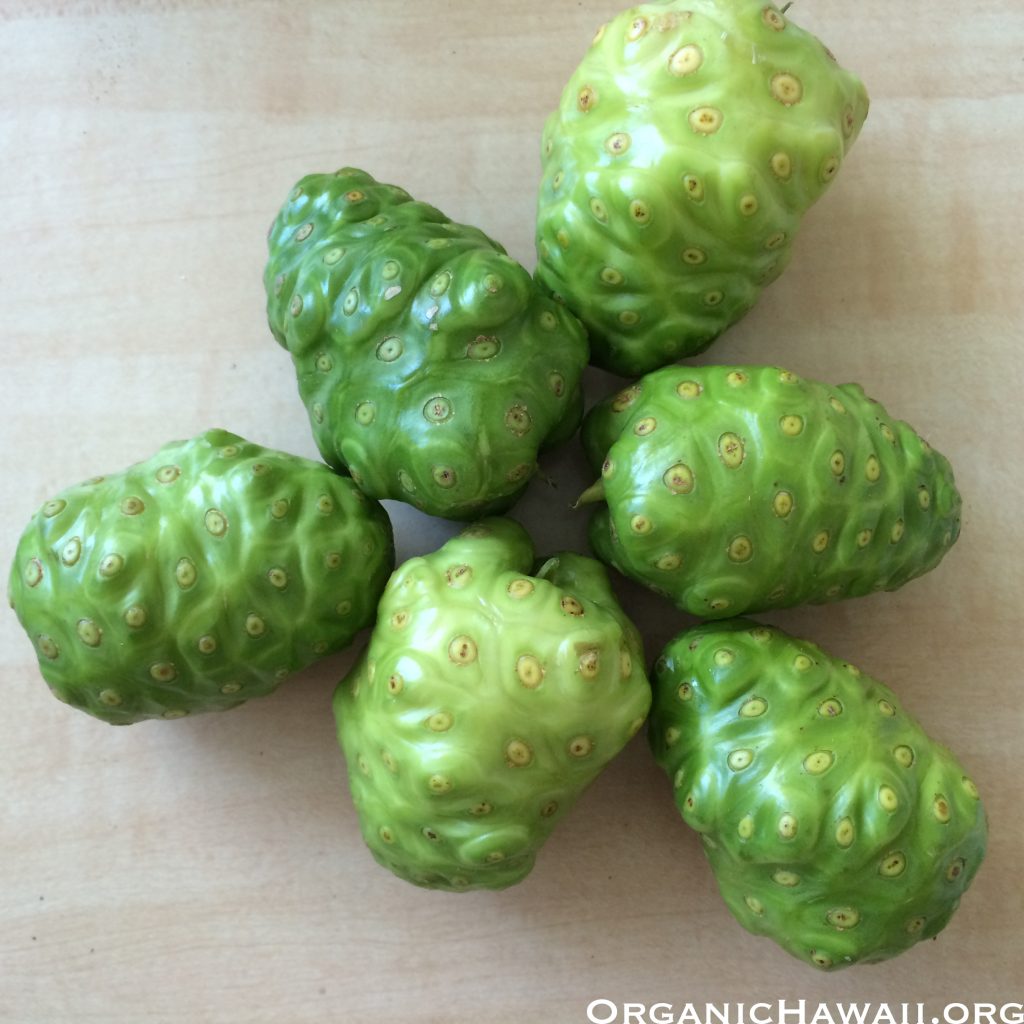
Step 1: Gather supplies
You will need:
- At least one large 4 liter clear glass jar with a wide mouth and a lid with rubber gasket. We recommend and use these ones.
- About seven medium size Noni fruits to fill the jar. Important: Noni fruit should not be unripe or overripe. If Noni is completely dark green that means it’s unripe – not good. If Noni is yellow, becoming translucent yellow it means it’s becoming overripe. So ideally Noni fruit should be very light yellow color. If Noni is soft and mushy it means it’s over-ripe, which will make it very hard to clean.
- Optional: fruit and veggie brush to clean Noni. This is recommended since air pollutants can get lodged in the crevices of Noni fruits (and everything exposed to modern air! 🙁 The brush is more affective at removing unwanted chemicals than just washing it with hands.
- Optional: fruit and veggie wash. This is a safe liquid wash which helps dislodge potential pollutants from the Noni, as well as any other produce you may want to wash.
- Optional: water filter. Water filter is a must for any household since all tap water has added chlorine (WWI chemical weapon knowns as mustard gas), may have fluoride (a rat poison), toxic heavy metals, and even “forever chemicals”! We prefer reverse osmosis water for drinking, but in our kitchen we use this 9-stage water filter which we recommend for basic meal prep, rinsing, and even brushing teeth.
- Optional; small glass jars or bottles to bottle your newly made Noni juice. We try to reuse our glass containers from previous purchases, but if that’s not available this is a good option.
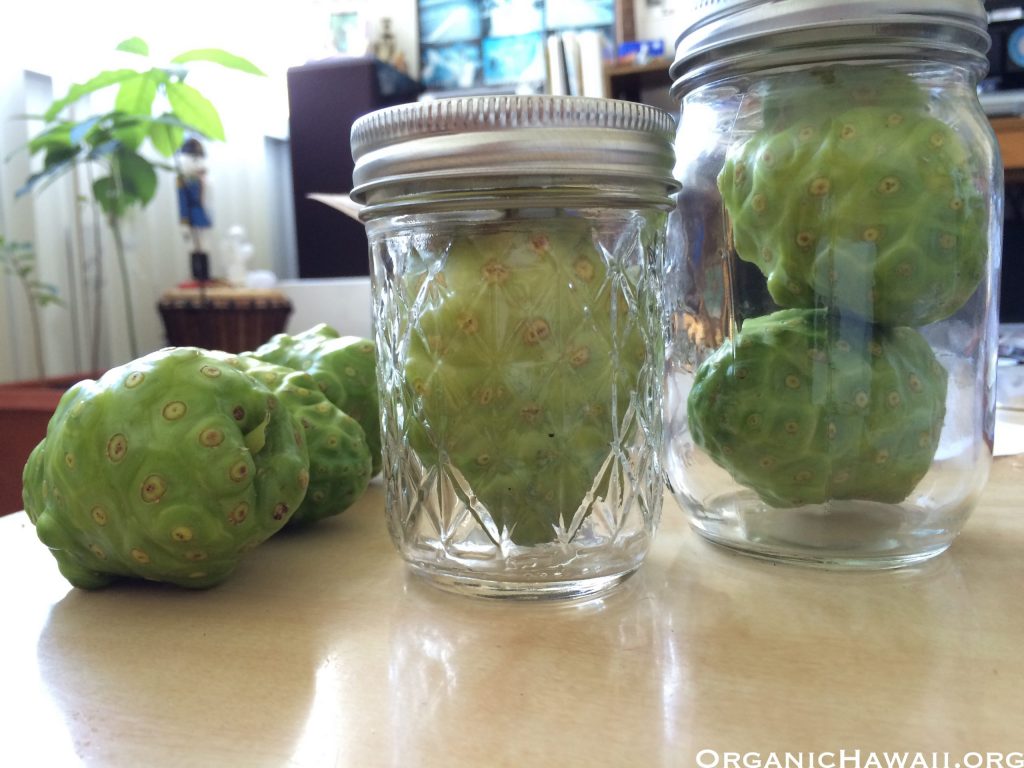
Step 2: Jar up the Noni!
First, clean Noni fruit by washing it and preferably rinsing it with filtered water.
Put the washed Noni fruit into a large 4 liter glass jar. Make sure the jar’s been washed well and preferably rinsed inside with filtered water. They don’t need to be dried. Filtered water reduces nasty contaminants of tap water and greatly reduces chlorine, as well as it’s nasty smell.
Fill up the jar with Noni fruit all the way to the top and close the lid. Make sure it’s tightly sealed with a rubber gasket and a latch.
Put the Noni jar in direct sun. If direct sun is not available, then partial sun is OK. If partial sun is not available, then you can keep it indoors, however the process will take longer and it will not taste as good as if it was exposed to the Sun.
It’s up to you how long you want to age the Noni. We prefer the more aging, so at least a month. We’ve held Noni jars for over a year and the juice was great!
Step 3: Collect your Noni Juice!
When you notice that enough Noni juice has been deposited at the bottom of your large jar you can open it up. Carefully pour the juice into a separate glass container such as a small jar or a glass bottle. If pouring into a bottle we recommend you use a funnel.
Hold the large jar with one hand while holding the lid slightly open with the other hand. This way the fruit stays inside, while the juice pours out. Don’t touch anything on the inside of the large jar to prevent contamination.
After you’re done pouring the juice close the large jar and put it back, so that more juice can be extracted. You can also add more Noni fruit to it at this point. Eventually the volume of original Noni fruit inside the jar will shrink, making room for new fruit. Just make sure you always have clean hands and utensils to prevent any possible contamination inside the jar.
Close the smaller jars or bottles (with freshly collected juice) and put them in the fridge for long-term storage. But don’t wait too long – enjoy the goodness and share it with your family and friends!
CAUTION: By the way, even though Noni is naturally resistant to bacteria and certain pathogens, if you see weird mold or weird stuff growing inside your jars you will need to dispose of it, clean and sanitize everything and start over.
I Want it NOW!!
Ok, you can buy it! Or if you’re a little patient you can drink your homemade Noni juice sooner.
The reality is Noni juice is drinkable as soon as the liquid starts to seep out of the fruits. It will be clear yellow color in the beginning. The taste won’t be as complex as aged Noni, but if you’re pressed for time, you don’t have to wait a month or longer. It can be a week or so.
As a matter fact, Noni fruit is listed in the army survival manual TM 10-420 Emergency Food Plants & Poisonous Plants of the Islands of the Pacific as one of the edible fruits in times of crisis! Yes, it’s not great tasting but in times of food scarcity taste becomes less relevant.
Having that said you can bite into Noni fruit when it’s soft and ripe, but there are seeds, texture, and taste issues you may not like.
Therefore, drinking properly made homemade raw Noni juice is a beautiful solution to this.
Patience is a virtue 🙂
The longer you hold Noni in the jar – the more juice will come out of it. It will start to turn into a beautiful golden color, then a beautiful bronze after lengthy aging under the Sun.
So it’s up to you when you want to collect the Noni juice. You can even taste it at different stages of the process to see which one stage you prefer.
We’ve tried all sorts of different Noni juices. Personally we prefer the really aged dark bronze colored Noni juice.
The ideal Noni juice taste can be described as a complex taste of pineapple, toasted coconut, semi-sweet with a pinch of tartness, grounding, yet uplifting. Balancing, calming, and meditative. It could easily be described as an acquired taste, that gets better with time, the more you drink it. Great Noni juice flavor is surely appreciated by those who appreciate best things nature has to offer.
We hope you enjoy your own homemade organic Noni juice and share it with your family and friends!
How to Find a Safer “Low EMF” Home, Work, and School
The truth is EMFs are impossible to avoid completely. But they can be reduced. Thus, a safer “low EMF” home, work, or school can be found with some research and proper tools.
Generally, the further you are from mobile base stations aka cell phone towers – the less high frequency EMF (RF) radiation you will experience.
Cell phone towers radiate very strong EMF signals at a very high frequency RF range anywhere from 2G, 3G, 4G to LTE. They enable our mobile phones to work properly by giving us reception and the Internet. But living in close proximity to cell phone towers has been linked to adverse health conditions ranging from minor ones like insomnia to major ones like cancer and DNA damage. (Source: Bioinitiative Report)
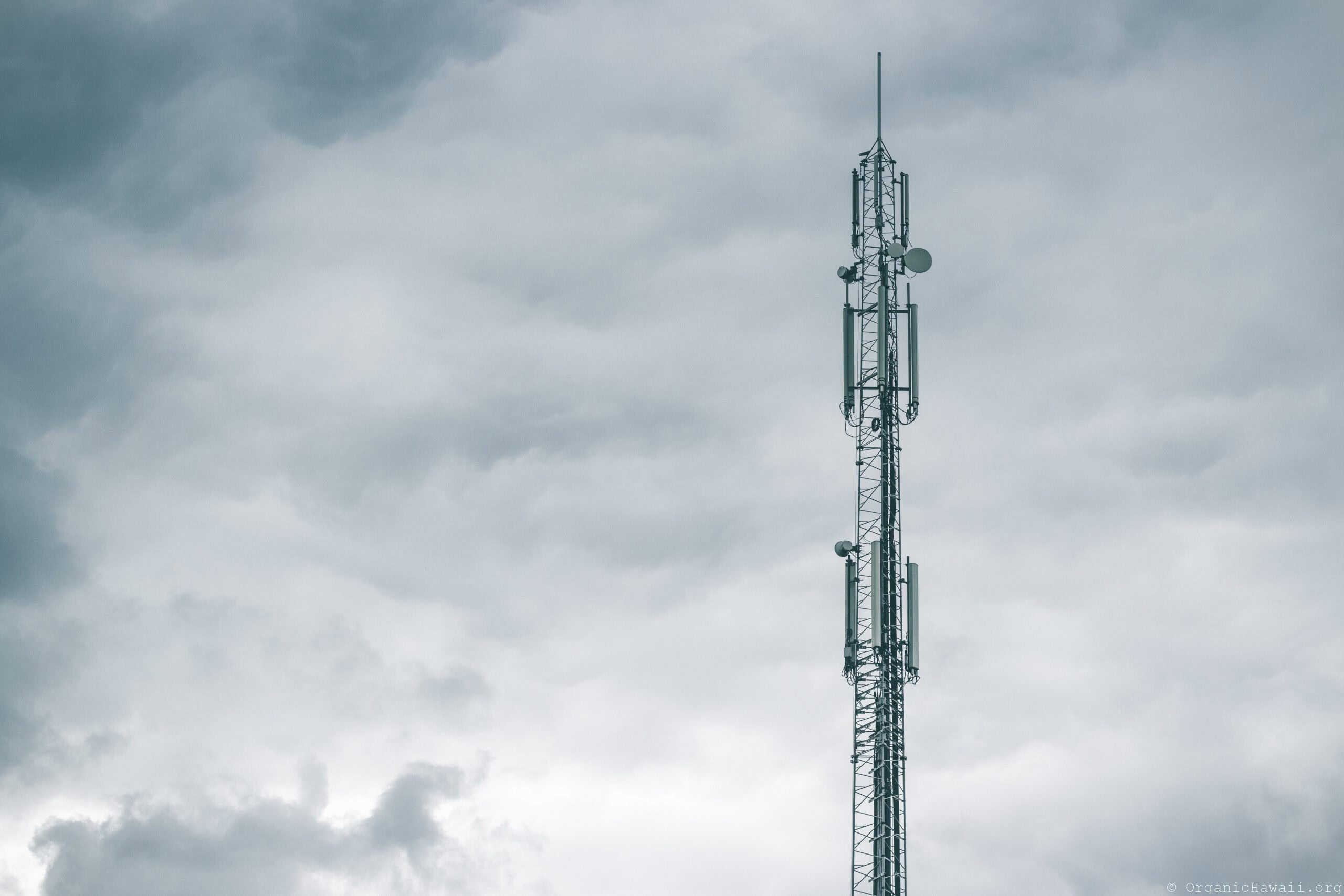
Therefore, it is prudent to live as far away from cell phone towers as possible. The trouble is that in an urban setting mobile cell phone towers can be spaced every few hundred feet apart. This ensures that you always have great signal, but at the expense of everyone being exposed to these harmful EMF frequencies.

It’s not easy to find a “low EMF” home, work, or school in an urban environment, but the effort is worth it in the long run. Especially for individuals with electromagnetic sensitivities (ES).
Some people are more sensitive to EMFs than others. In fact, some people are so sensitive to EMFs that they choose to abandon their work and home and live in the country where EMFs are the least. They become EMF refugees.
A great example of this is a story of a former Ericsson cell phone engineer Per Segerback who ditched the city life to escape the EMFs by living in the woods. He became an EMF refugee. Popular Science article
How to Find a Safer “Low EMF” Home, Work, and School
The Search Begins: Preliminary Research
We can only do our best to find a place to live, work, and go to school, that’s as far as possible from the nearest cell phone tower by doing preliminary research on the area.
If you’re moving to a new home, looking for a new place to work, or go to school you can use this awesome Cell Phone Tower Map Tool to look for cell phone towers nearby. For 5G towers locations you can use this Hawaii 5G towers map courtesy of Stop 5G Hawaii.
It’s also smart to double check the area using Google Maps in satellite and street view to look for objects that look like cell phone towers, since the Cell Phone Tower Map Tool did miss some cell towers.
In Hawaii cell phone towers are usually placed tall poles or on top of buildings’ elevator shafts – on the roof! They are usually white or gray thick rectangular antennas spaced closely and parallel to each other.
Why would they put cell phone towers on top of peoples homes? It’s because the building makes extra money from renting out that space to a cell phone company. At the expense of exposing people living nearby to these harmful EMFs.

Photo by: 7 Seth / Unsplash
What’s even worse is when the cell phone towers are placed right across from child daycare centers, schools, and hospitals where children and the sick are even more susceptible to health risks associated with EMFs.
Scouting the Area in Person
If the prospective area looks good on the map, next step would be to go there in person to make sure that there are definitely no cell phone towers nearby. Satellite and digital street maps are not in real time. And sometimes it’s hard to spot cell phone towers just from the map.
Going in person and scouting the area within at least a 300 foot radius of the proposed home, work, or school is a good idea. Again, special attention must be paid to building roof tops as well as tall poles with cell antennas.
Some mobile cell towers are camouflaged as trees! In Hawaii these fake trees are usually large palm trees or large pine trees. Their antennas will be painted dark green towards the top of the tree.
Affiliate disclaimer: As an Amazon Associate I earn from qualifying purchases. You don’t get charged extra and I make a small commission that supports Organic Hawaii. Thanks for your support.
How to Measure EMFs: HF, VHF, and RF
HF, VHF, and RF stand for “high frequency”, “very high frequency” and “radio frequency.” Microwave frequency is also part of this range.
Having an EMF meter like the Acousticom 2 is very helpful and recommended since it can show actual exposure levels in the immediate area. It’s extremely easy to use and it fits in the pocket.

The Acousticom 2 measures high frequency EMFs in the RF (radio frequency) microwave range from 200MHz – 8GHz. This range catches cell phone towers, Wi-Fi, smart meters, radar, cell phones, and common 5G frequencies. It even lets you hear these dangerous EMFs, which is helpful in determining its source. The audio function can be turned on and off.
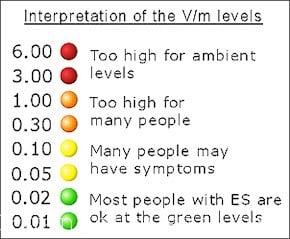
When we were apartment hunting we brought the Acousticom 2 to every potential apartment to test it during the previews. We turned down a few apartments due to high EMF readings from nearby cellphone towers.
The one we settled on had the lowest EMF readings and not a cell phone tower in the line of sight! We were so happy to find such a rare place in an urban environment of Honolulu.
Another way to test the area for (RF) EMFs is by looking at how many bars of reception you have on your cell phone. Generally, the less bars you have the further away a cell phone tower is, the less exposure from the tower.

Photo by Jonathan Hanna / Unsplash
How to Measure ELF and VLF Power Frequencies
ELF stands for Extra Low Frequency and VLF stands for Very Low Frequency.
To measure low frequency EMFs (ELF and VLF) from electricity inside the walls, substations, power meters, and electrical devices we use the PF5 Pocket Power Frequency Meter.

It’s the same size as the Acousticom 2, so it easily fits in the pocket. Most importantly it’s very easy to use with just one button and a clearly labeled scale. Basically you don’t have to be an engineer to interpret the results.

Using the PF5 Pocket Power Frequency Meter we uncovered an ungrounded MacBook Pro laptop. It was giving off strong magnetic signals – for years! We were able to eliminate these high magnetic frequencies after properly grounding the laptop. It was a very quick and simple solution with immediate results.
More importantly, the PF5 Pocket Power Frequency Meter helped us uncover a very strong magnetic field running along our office wall and through our bedroom! In essence, affecting our entire home.
It’s probably caused by ungrounded or poorly grounded electrical wires running through the wall. This is something we need to closely investigate in the near future.
The reason for our concern about this strong magnetic radiation is because it’s been linked to childhood leukemia in amounts as low as 2 mG! Our average was around 8mG and as high as 20mG!!!
Wi-Fi from your neighbors
Love thy neighbor (but not their Wi-Fi)
Another area to consider is your neighbors’ Wi-Fi networks, since Wi-Fi is another high frequency EMF source that travels through walls. New modern Wi-Fi routers are very strong and can emit 2 bands of frequencies: 2.4 GHz and a 5 GHz at the same time!
The worst type of Wi-Fi environment would be where you have neighbors all around you, such as an apartment building or a high-rise. And they most likely never turn their Wi-Fi off!
If feasible, moving to a corner unit might make some difference, but you may still have neighbors’ Wi-Fi below, above, and on two sides that you share walls with. I suppose that’s a bit better than being in the middle surrounded on all sides by the invisible sea of Wi-Fi.
In this case living in a single family home has a clear advantage of (hopefully) not having your neighbors’ Wi-Fi nearby.
One way to test this is to enable Wi-Fi on your smart phone, tablet, or laptop computer and see how many strong signal Wi-Fi networks it can pick up nearby. The more bars and the more Wi-Fi signals nearby – the more the radiation exposure from Wi-Fi EMFs.
Another way to test this is with an Acousticom 2 meter mentioned earlier. This will give you the actual measurement of all the high frequency EMFs (RF) around you.
Wi-Fi in Schools and Work
Wi-Fi in schools lately has become a subject of controversy. A child’s brain is more susceptible to the damaging effects of EMF radiation since their sculls are thinner than that of an adult. Plus their whole body is still developing!
Thus, EMFs can create problems in learning, productivity, behavior, and overall health of children. American Academy of Pediatrics article.
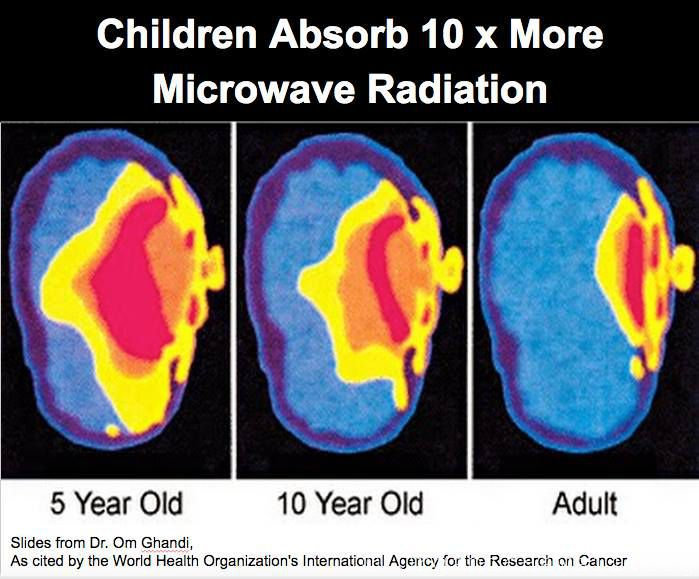
Because of this, certain health conscious, forward thinking schools such as Waldorf, Montessori, and many others have eliminated their school’s Wi-Fi use. Since our choices of schools are limited and the number of Wi-Fi free schools is very low we can only try to petition our local schools to at least reduce the number of Wi-Fi routers and instead use Ethernet cables to connect other devices.
At work this could be challenging too, so working as far as possible from a Wi-Fi router would be the simplest and quickest solution to reduce exposure.
Global Deployment of 5G
With the global rollout of 5G in urban areas it may be especially prudent to think ahead in terms of location of proposed and existing 5G towers. This map by Stop 5G Hawaii. shows 5G towers already in place in Hawaii!
Although 5G is a very high frequency microwave signal, 5G signals don’t travel as far as standard mobile network signals like 3G, 4G, and LTE.
Of course, this doesn’t make 5G towers any safer since they are a much higher microwave frequency. Furthermore, 5G towers are placed closer together, and closer to the ground than the traditional cell phone tower.

If Moving is Not an Option
If moving to a location that’s lower in EMF radiation is not feasible, then there are things you can do to reduce your EMF exposure from cell phone towers and neighbors’ Wi-Fi nevertheless.
You can implementing a Faraday cage type of shield design using EMF blocking materials on the walls, ceilings, roofs, and floors such as fine metal wire mesh, EMF blocking fabrics such as curtains for windows, and EMF blocking paints. These special materials can help reduce external sources of EMFs you would otherwise have no control over since they all come from the outside.
Picking a low EMF location in the city can be one of the hardest, but effective in the long term ways of reducing EMF exposure. From cell phone towers, “smart” meters, Wi-Fi signals, to high magnetic fields from poor electrical wiring.
There are more steps you can take to reduce harmful EMFs around you. For example, you can escape to a EMF-Free zone. And in our next article we will list 11 ways EMFs can be reduced or even eliminated in your immediate environment.
Header photo: Casey Horner / Unsplash












